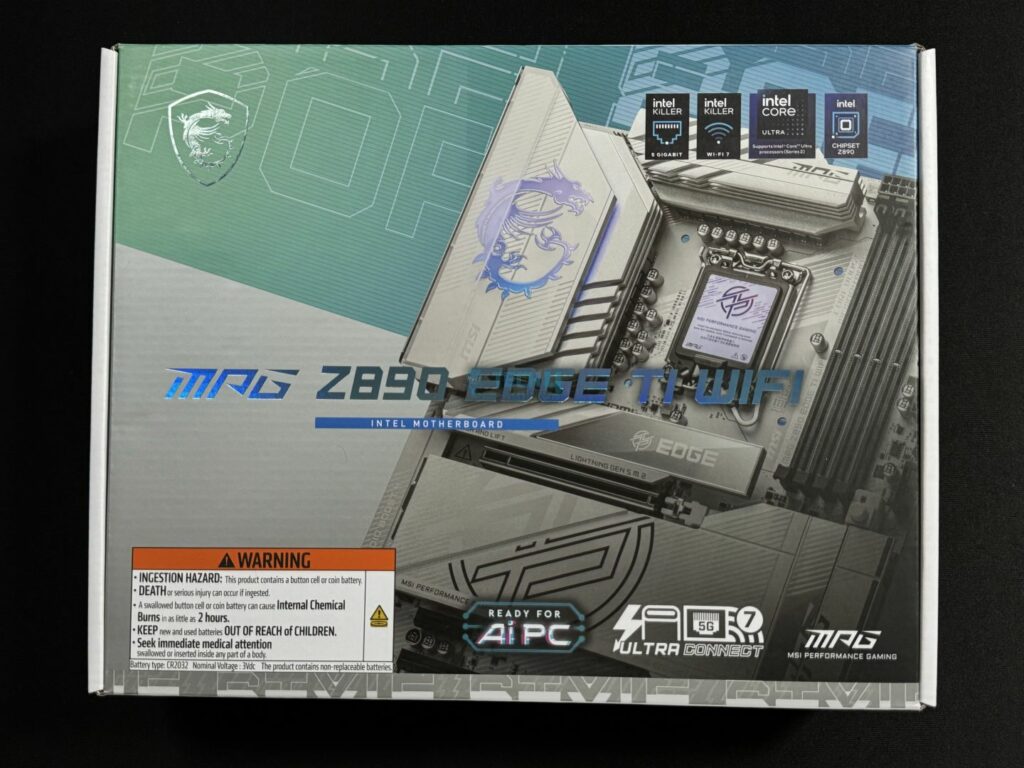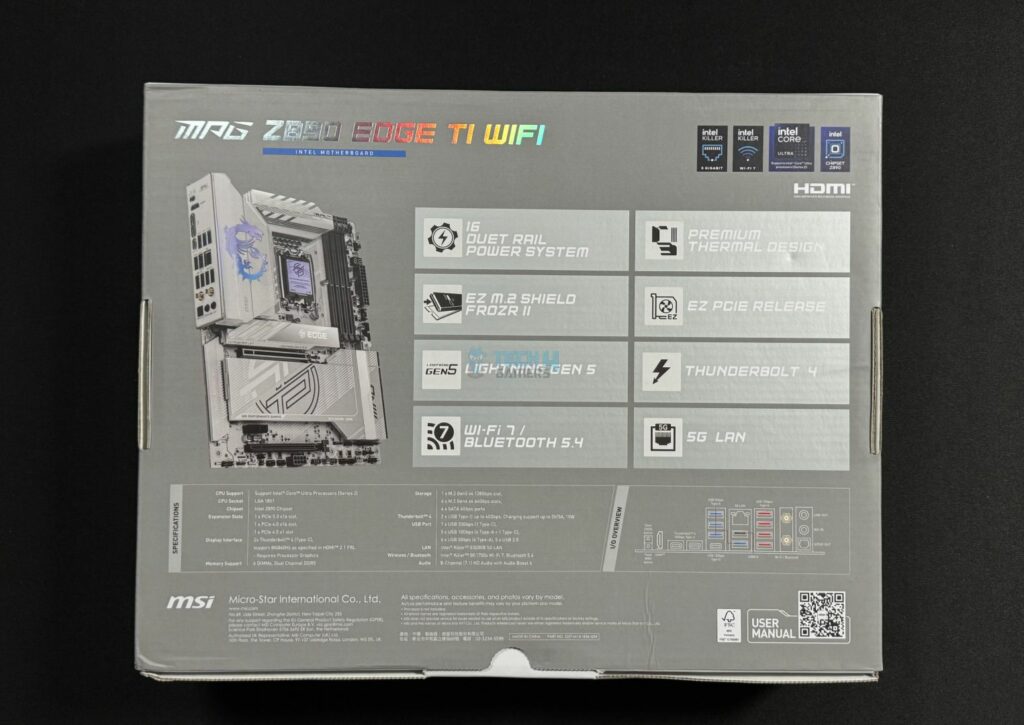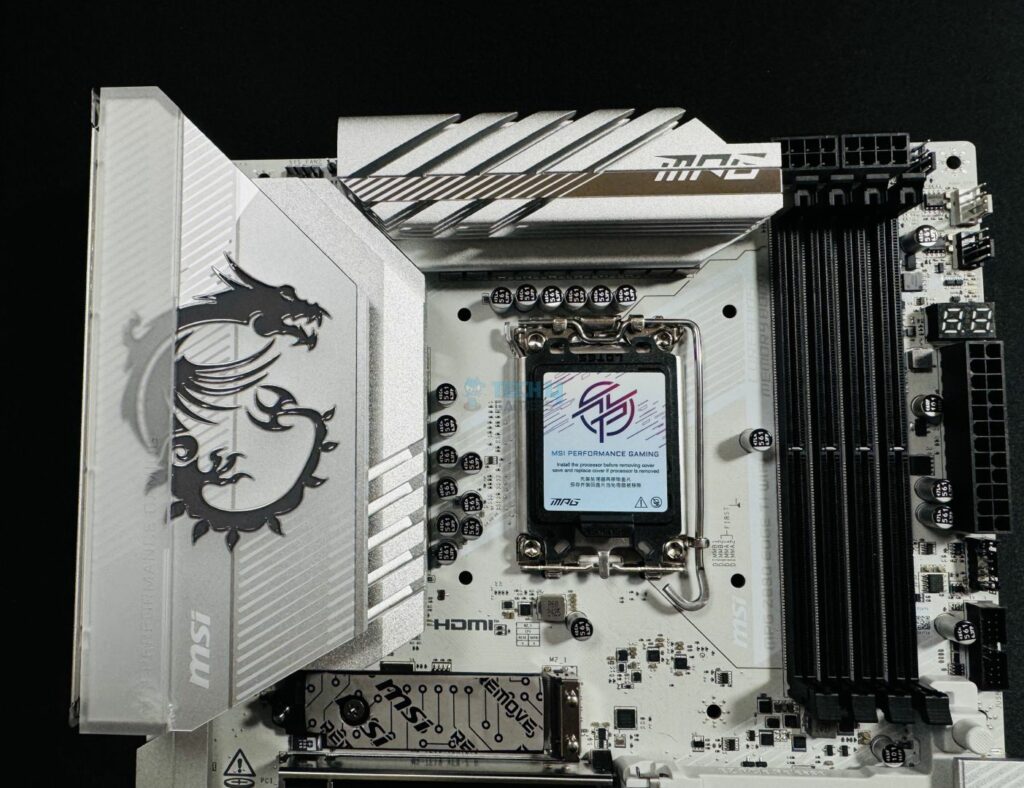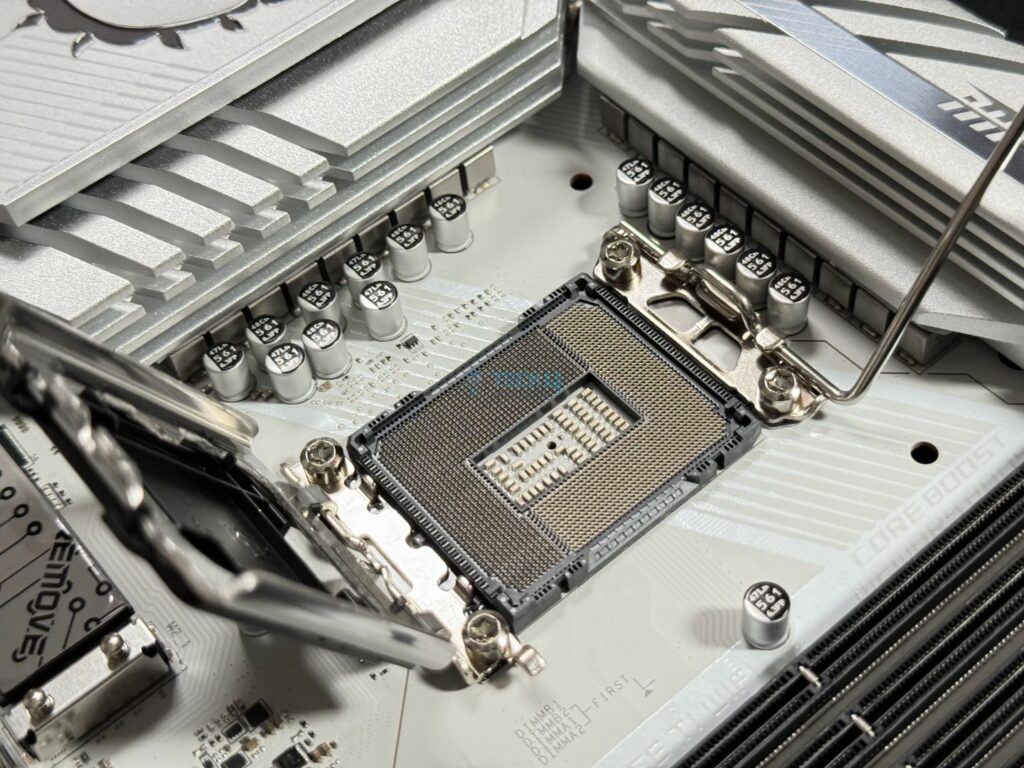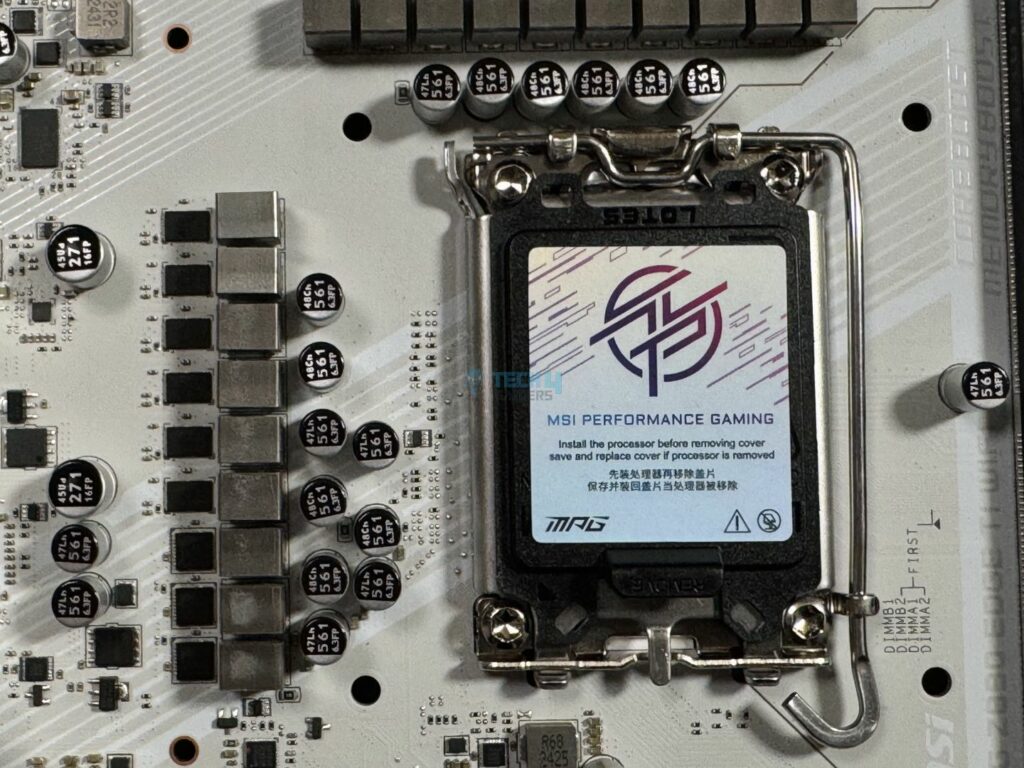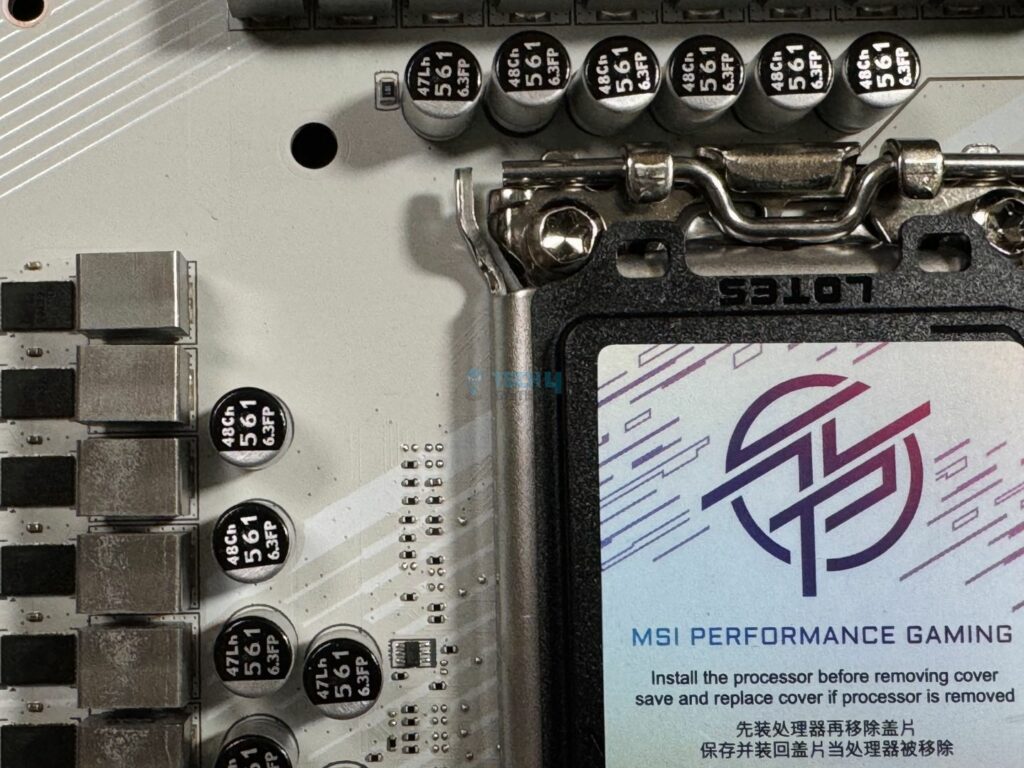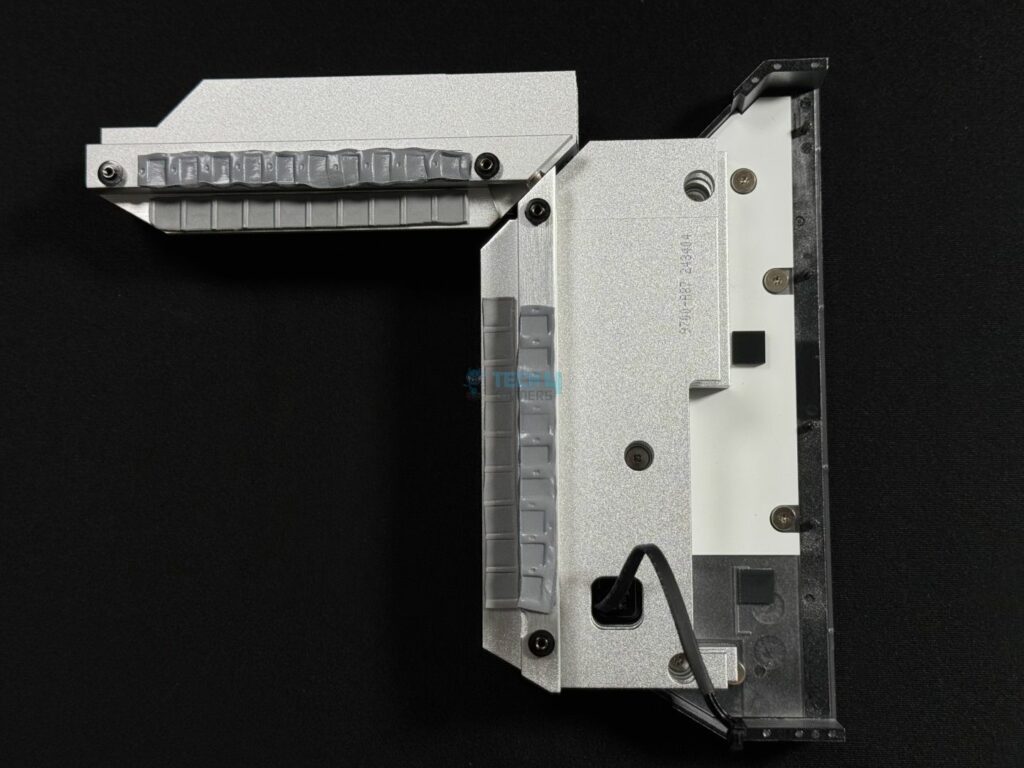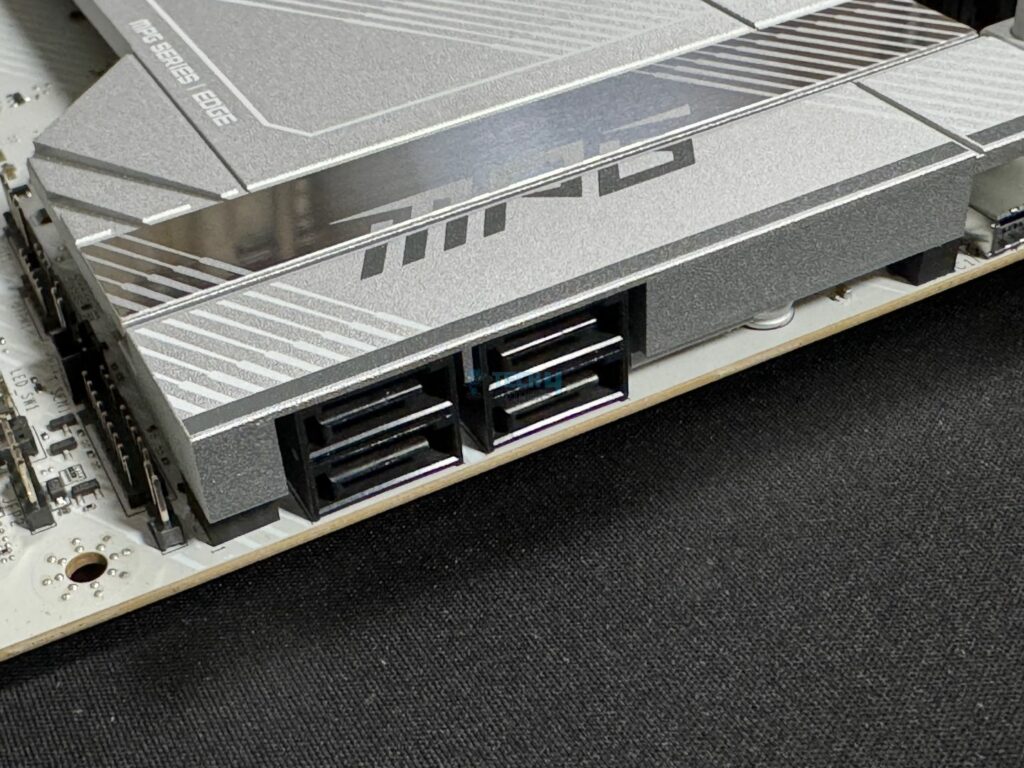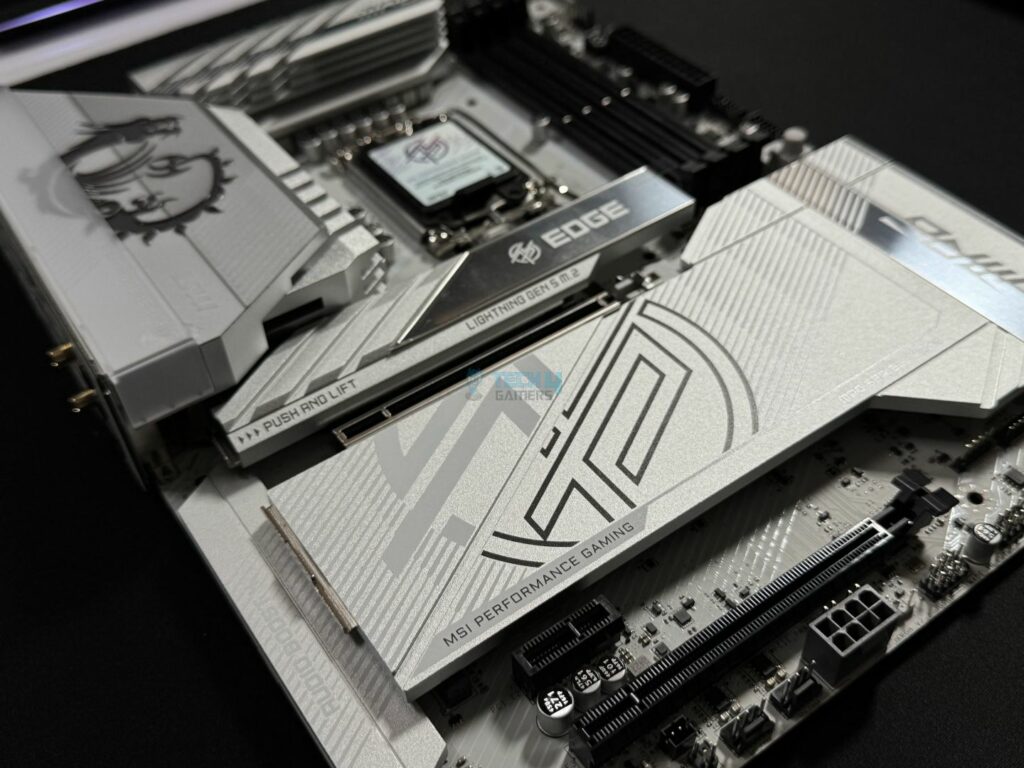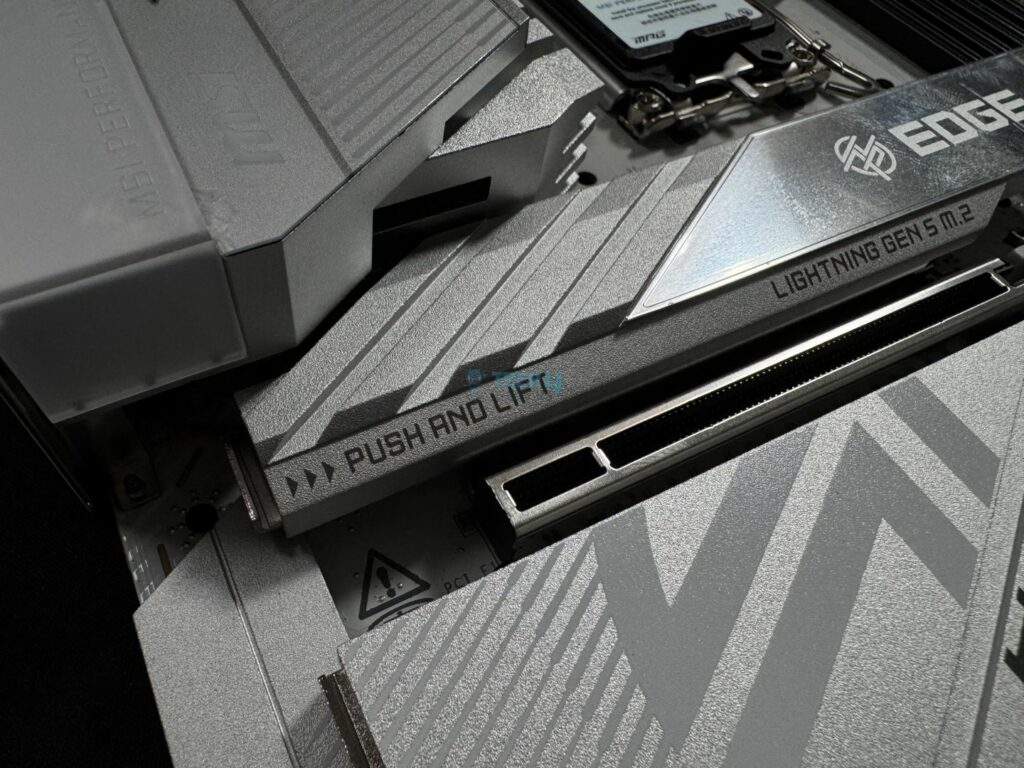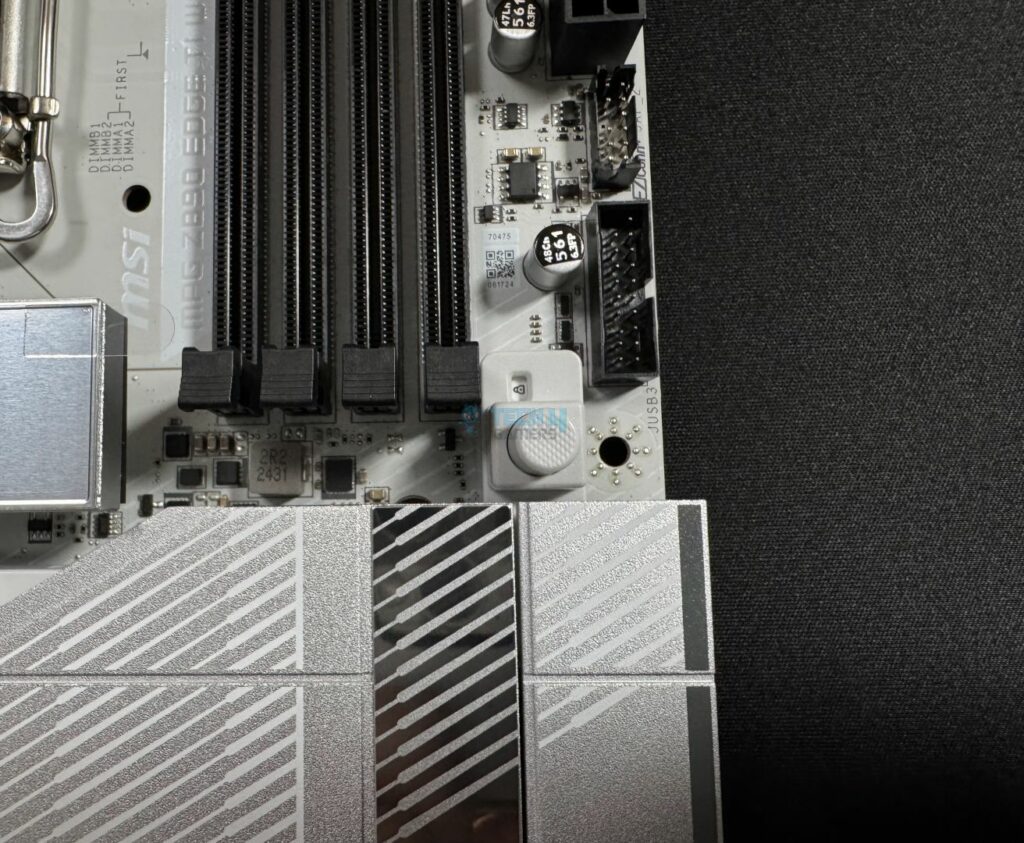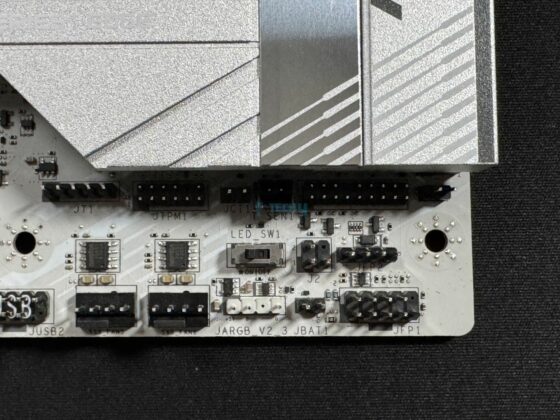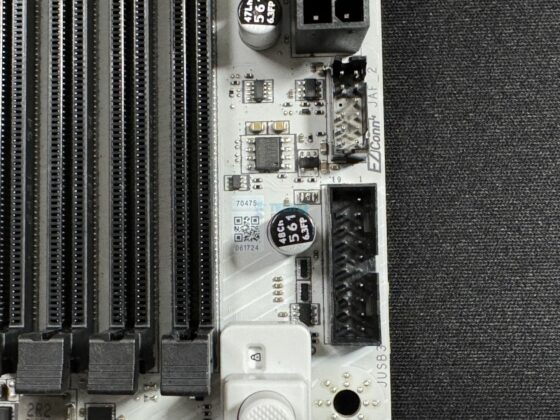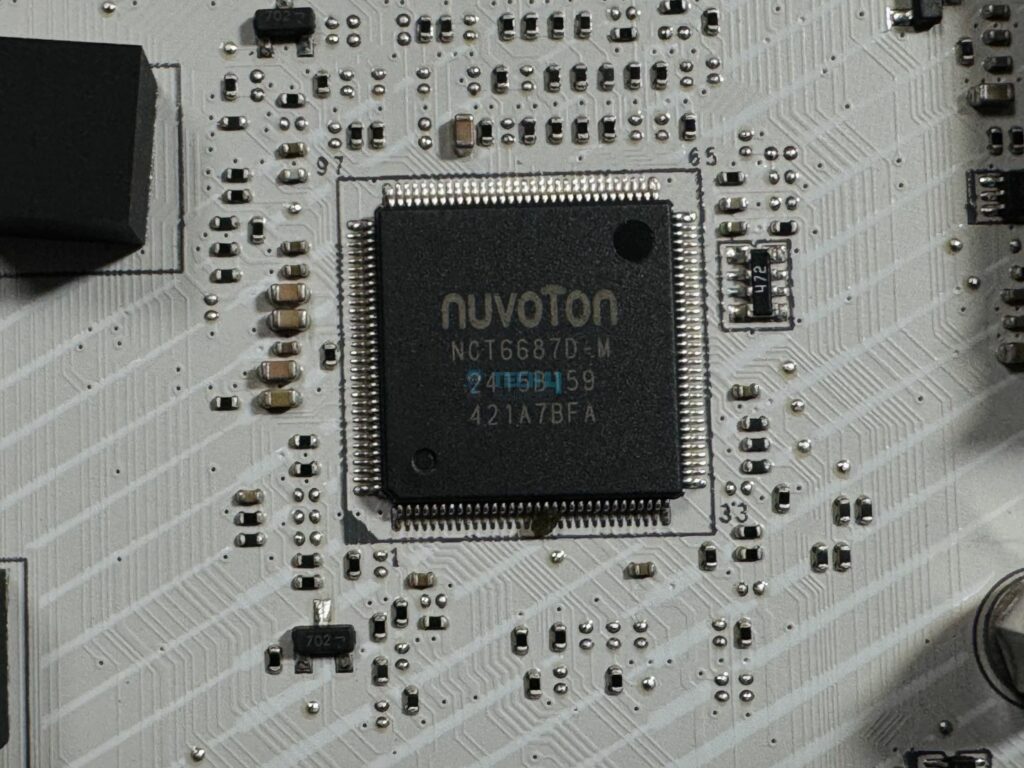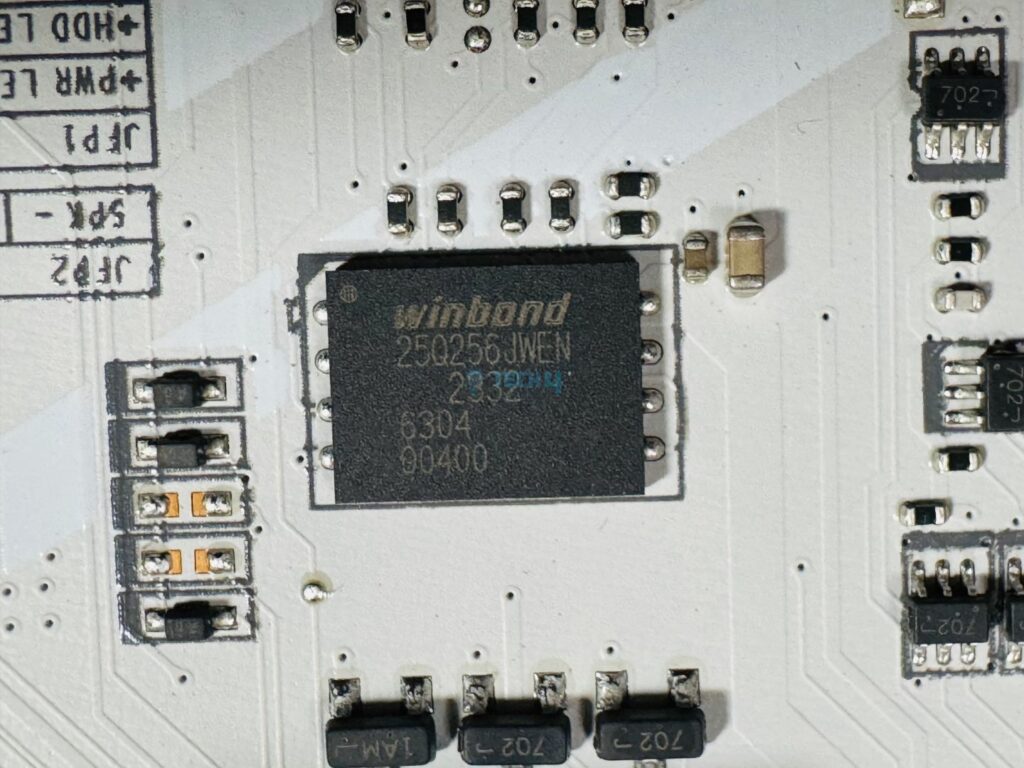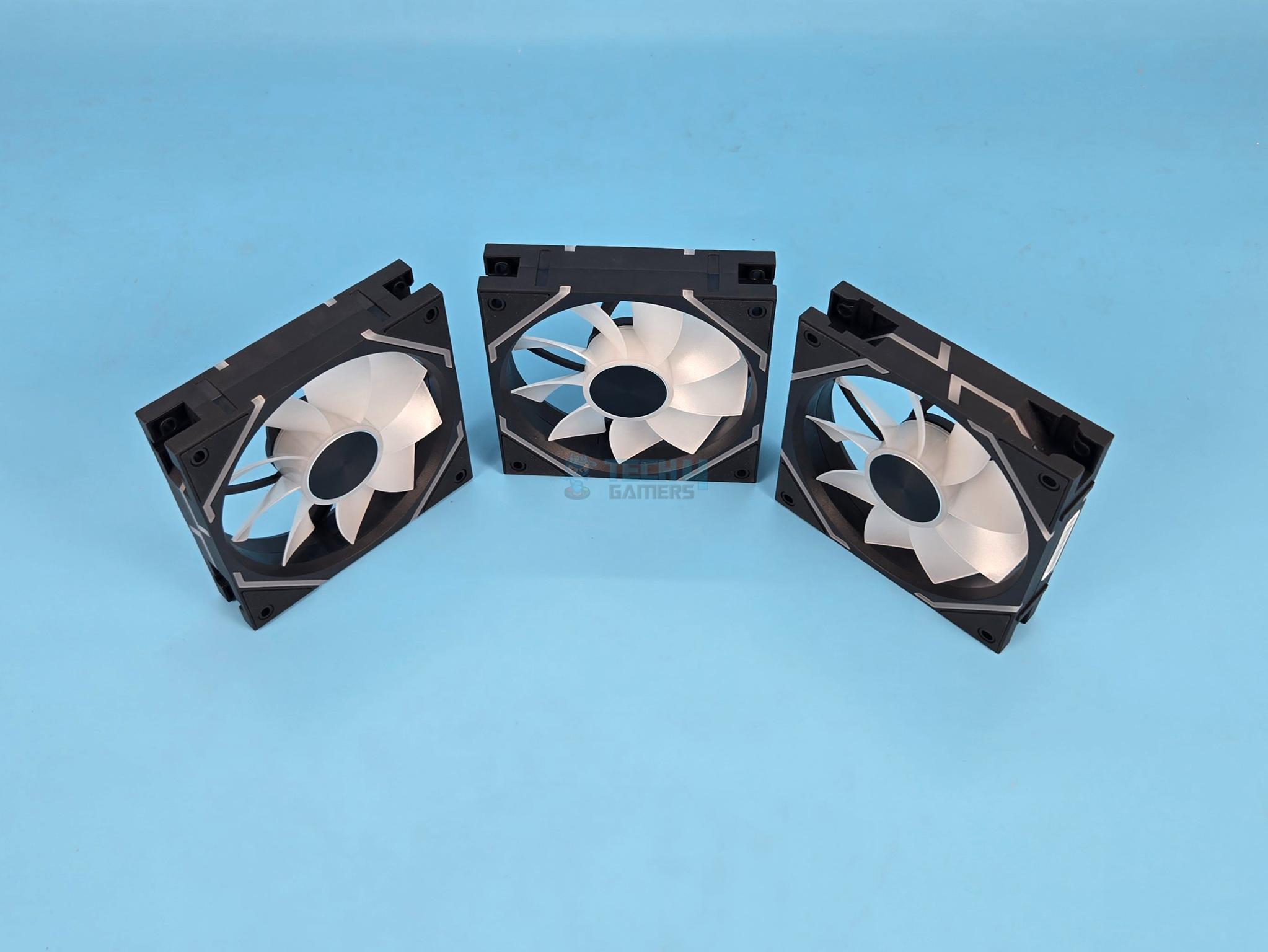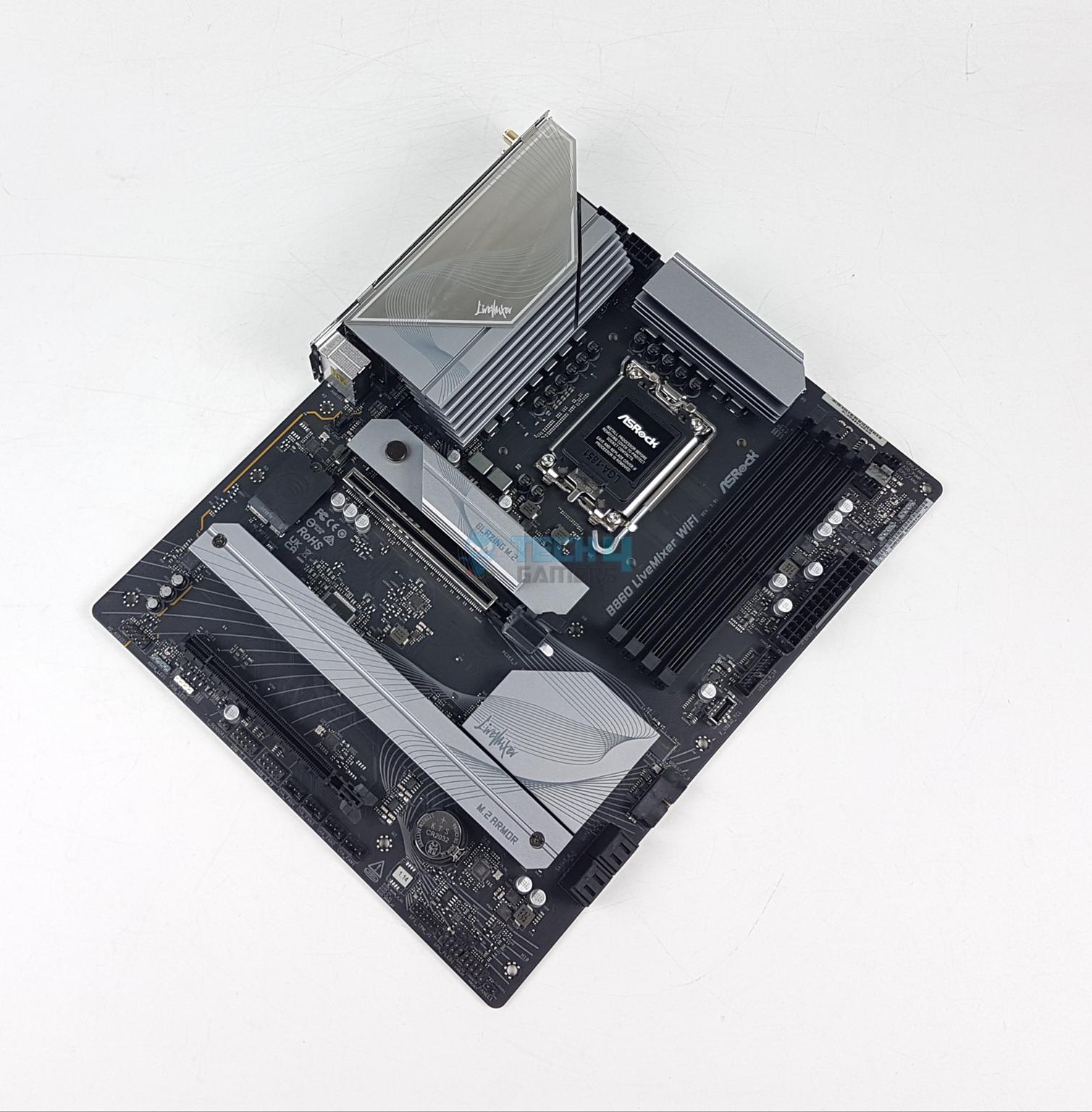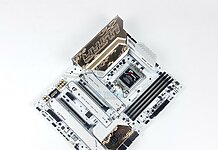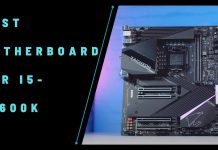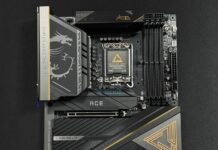A solid option, a bit pricey
Review Summary
The MSI MPG Z890 Edge Ti WiFi is a $369 gaming-focused board, and it certainly covers everything a gamer might need. That includes a great gaming-focused design with RGB and solid performance with a 16-phase 90A SPS design for CPU power. The board also offers the best I/O you can get right now, with DDR5 support up to 9200 MT/s, Thunderbolt 4, WiFi 7, and Bluetooth 5.4. You get 5G LAN, a decent audio solution, and room for up to 5x M.2 drives. Perhaps no feature is as good as the set of EZ-DIY features the board offers, though.
Hours Tested: 11

Overall
-
Performance - 8/10
8/10
-
Design - 9.5/10
9.5/10
-
Features - 10/10
10/10
-
Value - 8.5/10
8.5/10
Pros
- Decent 14+1+1+1 VRMs (incl. 16x 90A SPS for CPU)
- Fantastic all-white design featuring RGB
- EZ-DIY-focused design (incl. EZ PCIe release)
- 2x Thunderbolt 4
- WiFi 7 and Bluetooth 5.4
- Has a Thunderbolt 5 connection
- 5x M.2 slots
Cons
- Not the best VRM cooling
- A bit pricey for the VRMs offered
After our MSI Pro Z890-A review, we’re moving on to the MSP MPG Z890 Edge WiFi Ti. This motherboard is part of MSI’s gaming and design-focused MPG series and is priced at $369. This is a slightly lower tag than last generation’s Edge Ti-Max WiFi ($389) and carries an all-white theme instead of the black-and-white mix. What does the motherboard have to offer, though? Let’s dive in and see.
Key Takeaways
- The MSI MPG Z890 Edge Ti WiFi is a $369 board focused on high performance. It has an all-white design with RGB, capable VRMs, the latest I/O, and a handful of EZ-DIY features to make life easier.
- Buy the board if you want an eye-catching all-white board, need the latest I/O, prioritize convenience, or need ample storage space.
- Don’t get the board if you plan on heavily overclocking your CPU.
Here’s a quick table sum-up of the specifications:
| CPU Support | Intel Arrow Lake Core Ultra Processors (Series 2) |
| Memory Support | Up to DDR5 9200+ MT/s (OC) |
| PCIe Slots | 1x PCIe 5.0 x16, 1x PCIe 4.0 x4, 1x PCIe 4.0 x1 |
| M.2 Slots | 1x PCIe 5.0 (x4), 4x PCIe 4.0 (x4) |
| SATA Ports | 4x 6Gbps |
| Audio | Realtek® ALC1220P Codec |
| Network & Connectivity | 1x Intel Killer E5000B 5G LAN, WiFi 7, Bluetooth 5.4 |
| USB Ports | 19 ports, including 2x Thunderbolt 4 (Rear) |
| Size | 30.5 cm x 24.4 cm, ATX Form Factor |
| MSRP | $369.99 USD |
LGA1851: The Key Change
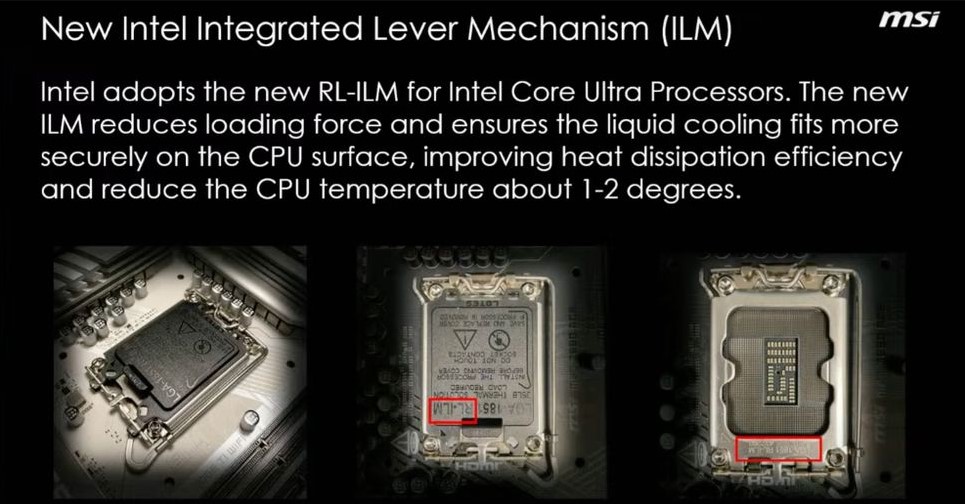
With LGA1851, the key parameters are the same as LGA1700; only the number of pins has increased. The main change is the new reduced-load ILM (integrated lever mechanism), which reduces load on the CPU (hence the name). While a fairly minor change, it was also very necessary, as the LGA1700 retention mechanism was known to apply uneven pressure across the CPU. This led to a tiny bend in the CPU IHS, affecting cooling performance.
The new mechanism distributes the pressure more evenly across the CPU, preventing it from deformation and improving the CPU cooler’s contact with it. This is more important than ever as Intel has switched to a multi-chipset design for these CPUs, and the heat output won’t be concentrated in a single area. According to MSI, this can reduce temperatures by 1-2 degrees.
Early reports showed that this mechanism only increases manufacturing cost by $1, requiring only two extra parts: an additional hinge frame insulator and a lever frame insulator. Manufacturers can reserve this mechanism for mid-range/higher-end boards, so we won’t see this in every new Arrow Lake-supporting motherboard.
Packaging and Unboxing
The motherboard box is predominantly grey-themed cardboard.
Key features are highlighted on the front, and cautions against mishandling of the CMOS battery are present on the bottom left. On the back, we get more details on its features, the specifications list, and a labeled rear I/O diagram. There’s a QR code on the bottom right to open the motherboard manual on your phone if the quick installation guide doesn’t cover everything for you.
Let’s look at the accessories that come with the motherboard:
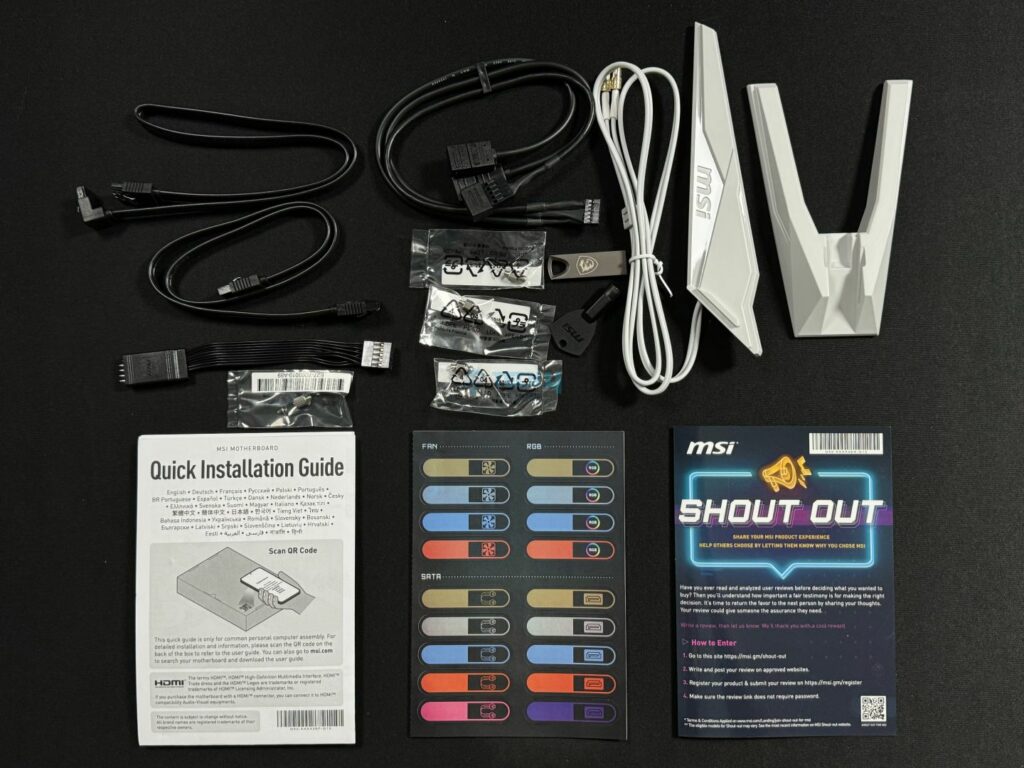
- Quick installation guide
- EZ-WiFi Antenna
- 1-to-3 EZ Conn-Cable (V2)
- EZ front panel cable
- 3x EZ M.2 Clip II
- EZ M.2 Clip II remover
- M.2 screw/standoff set
- 2x SATA cable
- USB drive
- Cable sticker pack
- Shout-out flyer
- EU Regulatory Notice
Accessories include 3x EZ M.2 clips (II) to simplify SSD installation/removal. The 1-to-3 EZ Conn-Cable V2 helps with cable management, combining an ARGB connector, system fan connector, and USB device into one. This is especially helpful for MSI’s liquid coolers utilizing the 11-pin designs.
The EZ front panel cable combines all those tiny front panel connectors so you can route everything neatly toward the back of your board. You also get utilities and drivers inside the included USB stick.
It’s thoughtful of MSI to include a white-coated WiFi antenna to match the motherboard’s theme.
Design
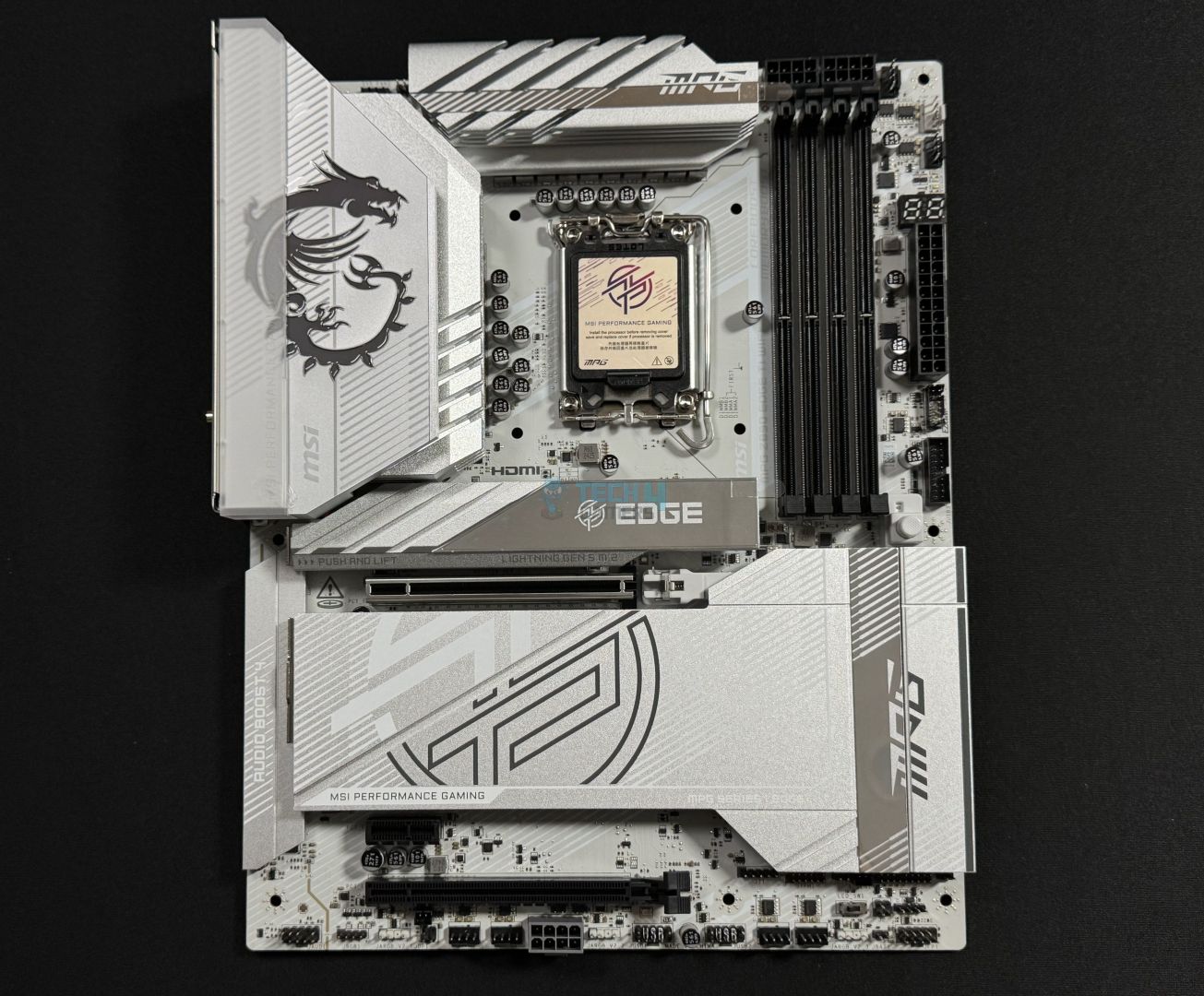
The design of this board is a carbon copy (pun intended!) of the MSI MPG X870E Carbon WiFi we tested earlier this month, only with the relevant branding and a white theme. We won’t complain; this is a nice design, and the white theme gives it a new life. There are also glossy silver accents on three of the heatsinks to finish off this stunning look.
The heatsinks complement each other nicely and are characterized by diagonal lines and grooves running through them. The MSI dragon on the I/O panel cover is RGB-illuminated and controllable through Mystic Light or aftermarket software.
The motherboard is built on an 8-layered NPG-170D server-grade PCB with 2oz thickened copper for integrity. It features transient voltage suppressors to protect itself against voltage spikes and over-current protection. There is also a grounding structure around the power phases, which uses copper rings to suppress the electromagnetic interference they generate.
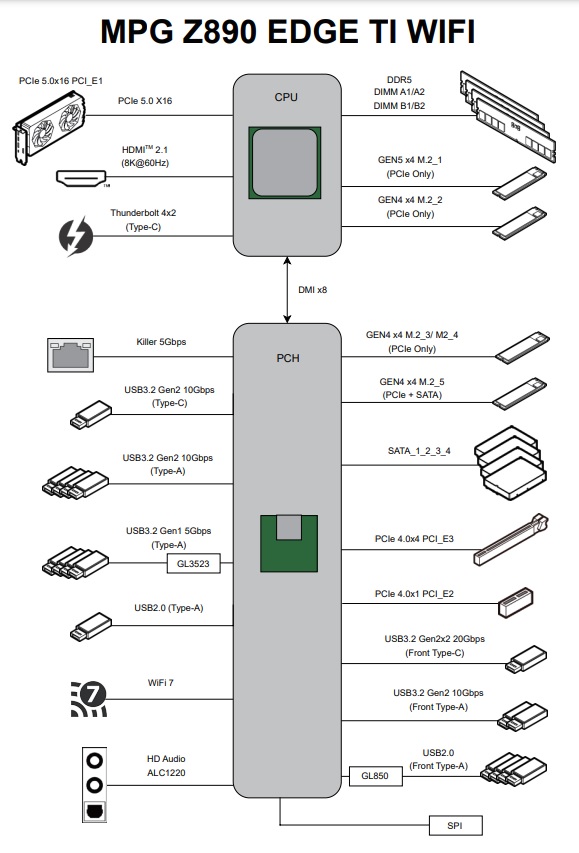
Most of the latest I/O comes from the CPU, including PCIe 5.0 x16, the Gen 5 M.2 slot, Thunderbolt 4, and DDR5 support. The CPU (with integrated graphics) also powers the HDMI 2.1 port. The CPU forms a DMI x8 4.0 link that Intel has been using since the 600-series chipset.
The chipset provides all the USB ports, the SATA ports, and the remaining M.2 ports, 5G LAN, WiFi 7, and audio. It also provides the remaining PCIe slots.
CPU Socket And Power Delivery
The CPU socket uses the RL-ILM mechanism we mentioned earlier, though it is not mentioned on the socket plate or cover. We know that all of MSI’s Z890 boards will feature this mechanism. The socket will support two more generations of Intel CPUs up to 2026.
The motherboard features 19 phases, with 16 of those reserved for VCore. These 16 phases are 90A SPS, while 1 phase each is dedicated to SA, GT, and AUX power. In total, 1440A is available for the CPU, more than enough juice for the beefiest Arrow Lake CPUs. The VRMs utilize capacitors storing up to 560µF and withstanding up to 6.3V.
We get a BCLK generator on the board which enables BCLK overclocking.
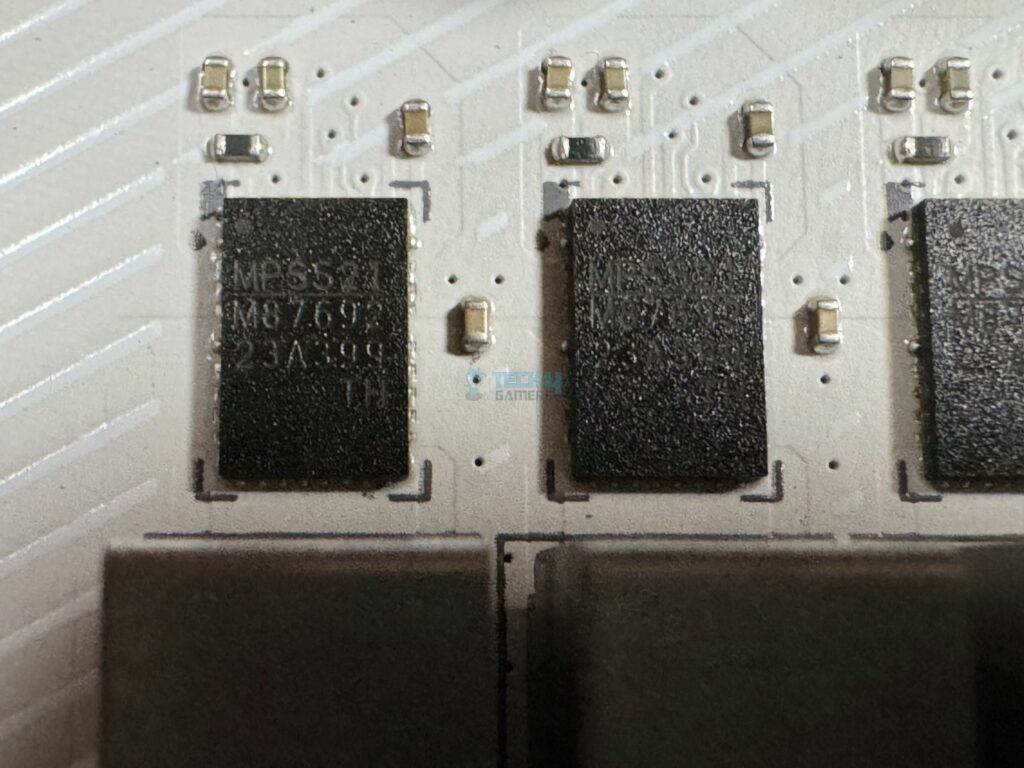
These are MPSS21 MOSFETs, labelled “M87692-23A399,” and the driver for these MOSFETs is the MPS 2425 “MP29005-A” PWM controller.
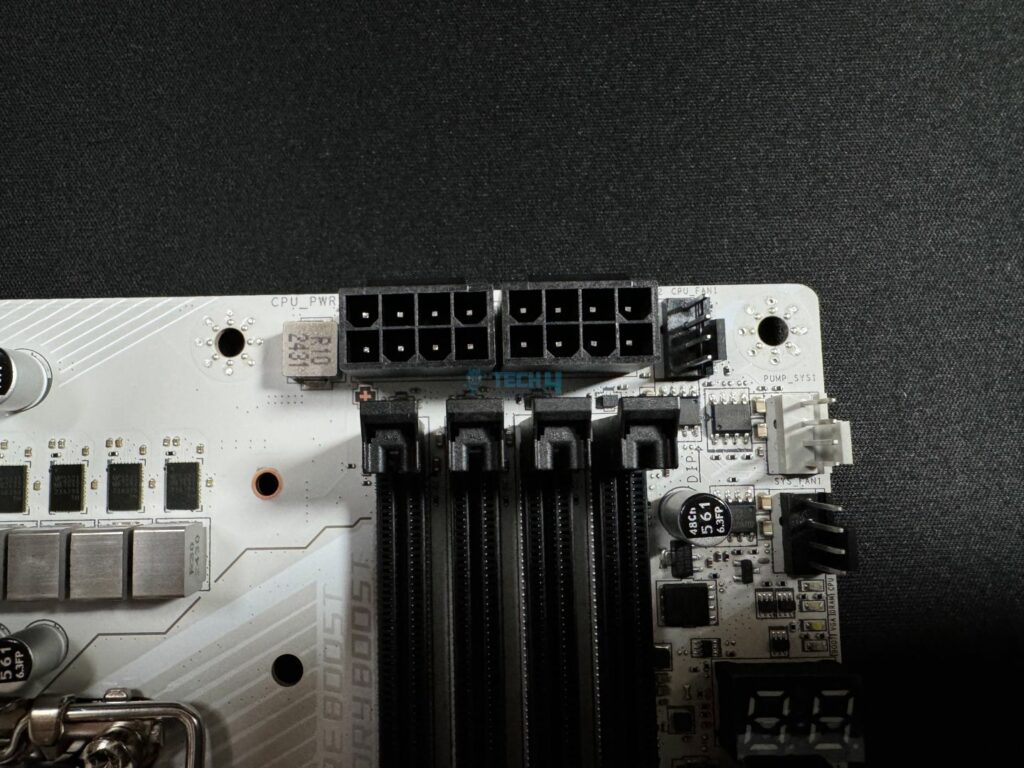
The dual 8-pin EPS connectors provide the CPU with power up to 300W. These connectors use solid pins, and MSI claims that this allows for a more stable transmission of 12V power. This is thanks to lower impedance and stronger durability. As a reminder, the Core Ultra 9 285K (the most powerful CPU of the generation) is rated at 250W max.
Let’s look at the VRM cooling at hand.
The motherboard cools the VRMs using heatsinks with stacked fin designs. The smaller one has four thick fin layers, and the larger one has three. The heatsinks are connected by a heat pipe and feature MOSFET plus choke thermal pads underneath.
DIMM Slots
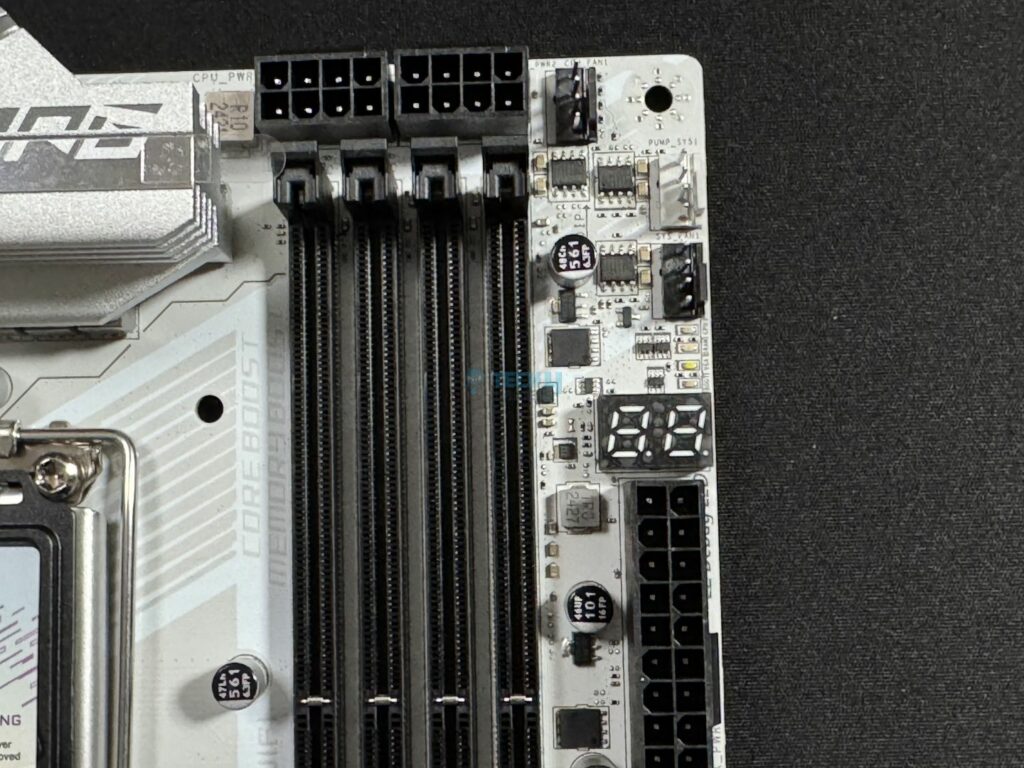
The motherboard features 4x DIMM slots with 2x channels. These slots are surface-mounted and have single-sided latches only. The maximum capacity supported is up to 256GB of RAM at 64GB per channel across two channels. It supports DDR5 speeds of up to 9200 MT/s with XMP/overclocking. Here are the memory speeds supported in different configurations:
- 1DPC 1R = 9200+ MT/s
- 1DPC 2R = 7200+ MT/s
- 2DPC 1R = 4800+ MT/s
- 2DPC 2R = 4800+ MT/s
The mother supports CUDIMMs, the latest DIMM standard. CUDIMMs feature a built-in clock driver to regenerate the clock cycle, which is otherwise done by the CPU, enabling better signal integrity. These memory modules should be able to achieve faster speeds than UDIMMs, so we can expect some records to be broken soon.
MSI Memory Boost Technology is highlighted beside the DIMM slots. Our understanding is that the technology ensures the best signal is established between the RAM and the CPU. This is done by ensuring there are no components between the CPU and the slots. It also uses an isolated memory circuit, so there’s no interference from nearby components. Also, the routing path is “optimized” to ensure the fastest signal.
In addition, MSI also provides Memory Extension Mode for “Optimized memory parameters” to enhance lower latency at the same frequency. This mode can combine XMP profiles to create the best configuration.
Storage Options
The board offers 4x SATA 6G ports and 5x M.2 slots (1x Gen 5, 4x Gen 4). Slots 1, 2, and 3 support 2280/2260 drives, #4 supports 22110/2280 devices, and M2_5 can support either 22110, 2280, or 2260 drives. All storage options support RAID 0, 1, 5, and 10 configurations. M.2 signal sources are printed on the board to allow for easy identification.
Two incredibly stylish heatsinks cool the drives. Let’s remove them and take a look. Both feature MPG branding; the primary heatsink has a glossy silver section, and the second heatsink has a large MPG branding, divided into black and grey by a groove in the middle.
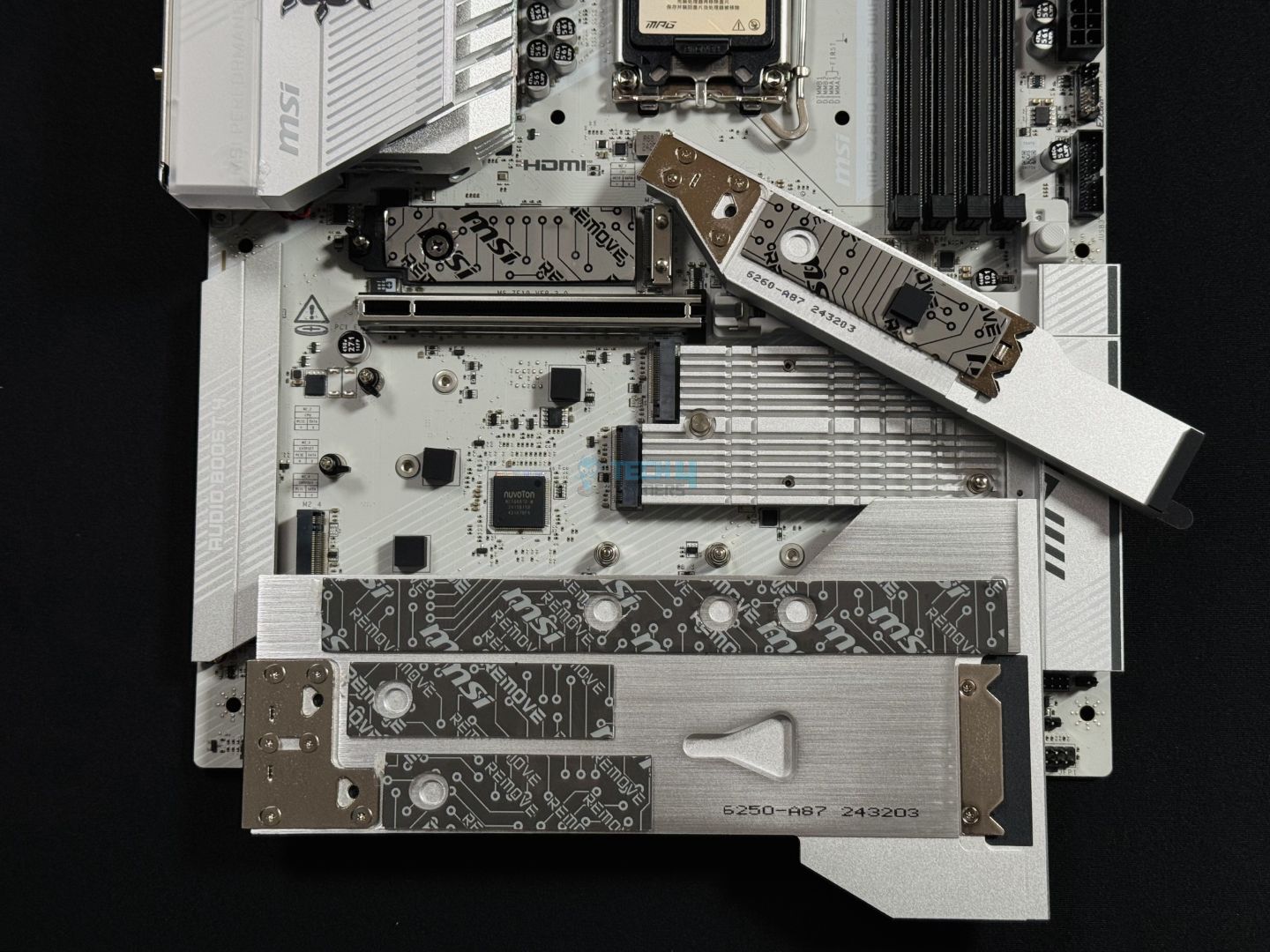
We were happy to see that both of them feature EZ PCIe release mechanisms. Underneath, we get 3x EZ M.2 Clips II for toolless SSD installation/removal, covering slots M2_1, M2_4, and M2_5. The extra clips included in the package will cover the rest of the mounting holes. On slots M2_2 and M2_3, you’ll be limited to the latch mechanism for installing 2280 drives.
All the heatsinks have thermal pads installed for efficient heat transfer. M2_1 also features a thermal pad at the base. An aluminum heatsink cools the PCH.
PCIe Slots
The board has 3x PCIe slots, including a primary PCIe 5.0 x16 slot. On the lower side, we get a Gen 4 x4 slot and Gen 4 x1 for expansion cards. The Gen 5 slot (pictured) is enforced with MSI Steel Armor II, with MSI claiming an improved weight endurance of 21%. This slot is also surface-mounted to minimize interference and noise.
The EZ PCIe release button allows the GPU to be removed with one hand through only a gentle press. This is our favorite implementation of the mechanism, as you simply need to press and release the button to switch the lock between open and closed configurations. It features a little padlock icon to add even more convenience; always know whether it’s in the open or closed state.
USB Connectivity
The board features 19 USB ports:
- 1x USB 2.0 (Rear)
- 4x USB 2.0 (Front)
- 4x USB 5Gbps Type A (Rear)
- 2x USB 5Gbps Type A (Front)
- 4x USB 10Gbps Type A (Rear)
- 1x USB 10Gbps Type C (Rear)
- 1x USB 20Gbps Type C (Front)
- 2x Thunderbolt4 (Rear)
We get dual Thunderbolt 4 ports and a USB 20 Gbps connection. The 20 Gbps port supports 27W charging. Remember, USB4 and Thunderbolt 4 are essentially similar: only Thunderbolt 4 has higher minimum requirements, including that of power.
In addition to speeds of up to 40Gbps, Thunderbolt 4 can connect up to 3x Thunderbolt 4 or 5x Thunderbolt 3 devices. It supports up to an 8K 60 Hz display and charging speeds of up to 15W.
Controllers for USB ports include Genesys GL850G for USB 2.0 and GL3523 for USB 5Gbps ports.
Network and Connectivity
The board has an Intel Killer E5000B 5G LAN port, and the Intel Killer BE1750x adds WiFi 7 and Bluetooth 5.4 support. The EZ Antenna features a magnetic stand that attaches to your chassis. The Intel Killer Performance suite comes with the LAN/WiFi. It offers features like Smart Access Point selection, which ensures you get the most stable wireless connection. Auto application priority detection, bandwidth analysis, and management are some other features it offers.
WiFi 7 and Bluetooth 5.4 require Windows 11 24H2.
Audio Solution
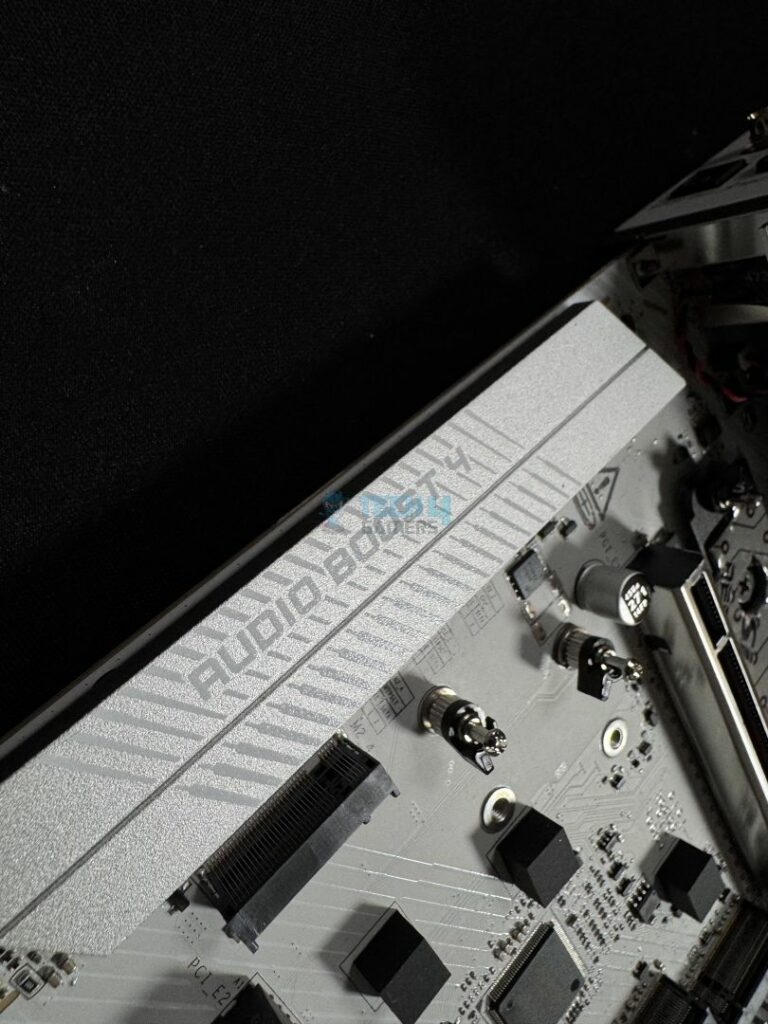
The board uses Realtek’s ALC1220P solution for audio and the ESS 9118 DAC for the rear audio. This solution lies under the Audio Boost 4 cover. The technology involves the use of high-quality audio capacitors, a dedicated headphone amplifier, and de-pop protection. Also, the left and right audio channel layers are separated in an isolated audio design.
Internal Connectors And Components
Here’s the list of the internal connectors:
- 1x Thunderbolt5 card connector
- 1x 24-pin Power Connector
- 2x EPS Power Connectors
- 1x Power Supplemental PCIe Power Connector
- 1x CPU Fan
- 1x Combo Fan
- 6x System Fan
- 1x EZ Conn-header
- 2x Front Panel
- 1x Chassis Intrusion
- 1x Front Audio
- 1x Thermal Sensor connectors
- 3x Addressable V2 RGB LED connector
- 1x RGB LED connector
- 1x TPM pin header (Supports TPM 2.0)
- 4x USB 2.0 ports
- 2x USB 5Gbps Type A ports
- 1x USB 20Gbps Type C ports
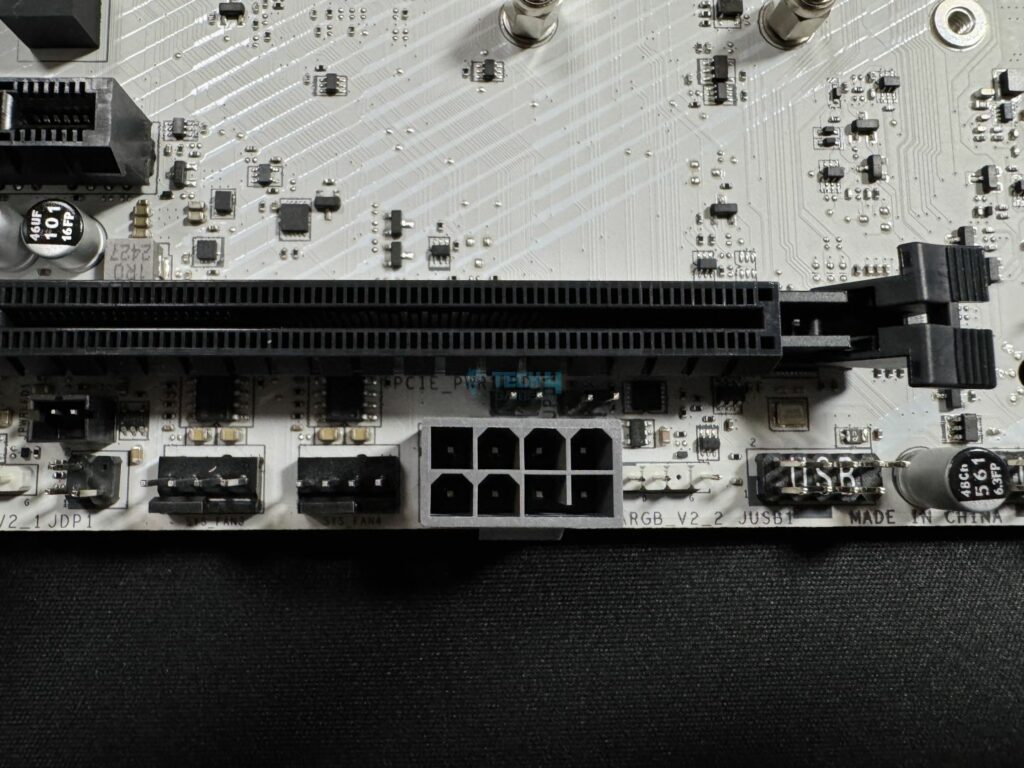
The first highlight is the supplemental 8-pin PCIe connector. It aims to provide extra power to your motherboard when it is overloaded with peripherals using the 24-pin ATX connector. This connector adds another 252W of 12V power, combining with the 24-pin ATX to supply 420W in total.
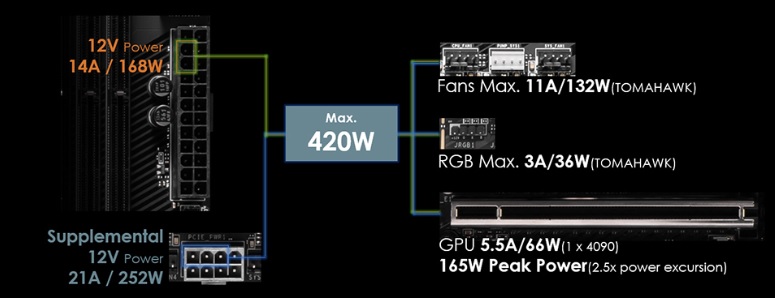
This includes up to 132W for the fans and 36W for RGB. Occupying all of the motherboard’s fan and RGB connectors should be no problem.
It also supports the 2.5x power excursion for the PCIe slots. Power excursion refers to a short burst of power supply, so you can’t rely on it to power graphics cards that aren’t fueled enough by the PCIe connectors/slots. In any case, the peak power from PCIe is increased to 165W.
Secondly, the board adds a Thunderbolt 5 connector (JTBT5_1) to support those devices when the time comes. Thunderbolt 5’s advancements include double the bandwidth over Thunderbolt 4 (at 160 Gbps) and the ability to power dual 8K 60Hz displays.
You get a thermal sensor connector to connect a thermistor cable at the bottom right, but no cable is included with the board. The EZ front panel cable is also located here, while the proprietary EZ Conn-Cable connector is located beside the DIMM slots.

You get EZ debug LED as well as the EZ Digi-Debug LED panel for troubleshooting booting issues, top-right of the board. The latter can also function as a temperature monitor.
The motherboard uses Nuvoton’s NCT6687D chip to control and monitor the fans, voltages, and temperatures across the board. For serial flash memory, the board uses Winbond’s W25Q256JW chip (256Mb).
Rear I/O Panel
Here’s what you get on the rear I/O panel:
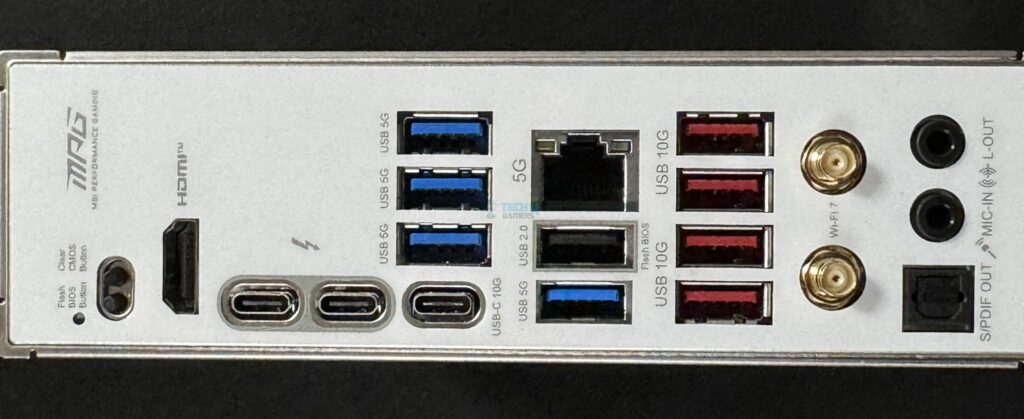
- USB 5Gbps Type-A
- 5G LAN
- USB 10Gbps Type-A
- Wi-Fi / Bluetooth
- Audio Connectors
- Clear CMOS Button
- Flash BIOS Button
- HDM 2.1 port
- Thunderbolt 4
- USB 10Gbps Type-C
- USB 2.0
- Optical S/PDIF Out
The rear panel is white and features a small “MPG” logo. We get both a clear CMOS and a BIOS flash button. MSI’s labeling of the USB port speeds rather than the name of the standards is good to see. The I/O shield is made of stainless steel and comes pre-installed.
Since we have already looked at the top I/O cover, let’s take it off and see.
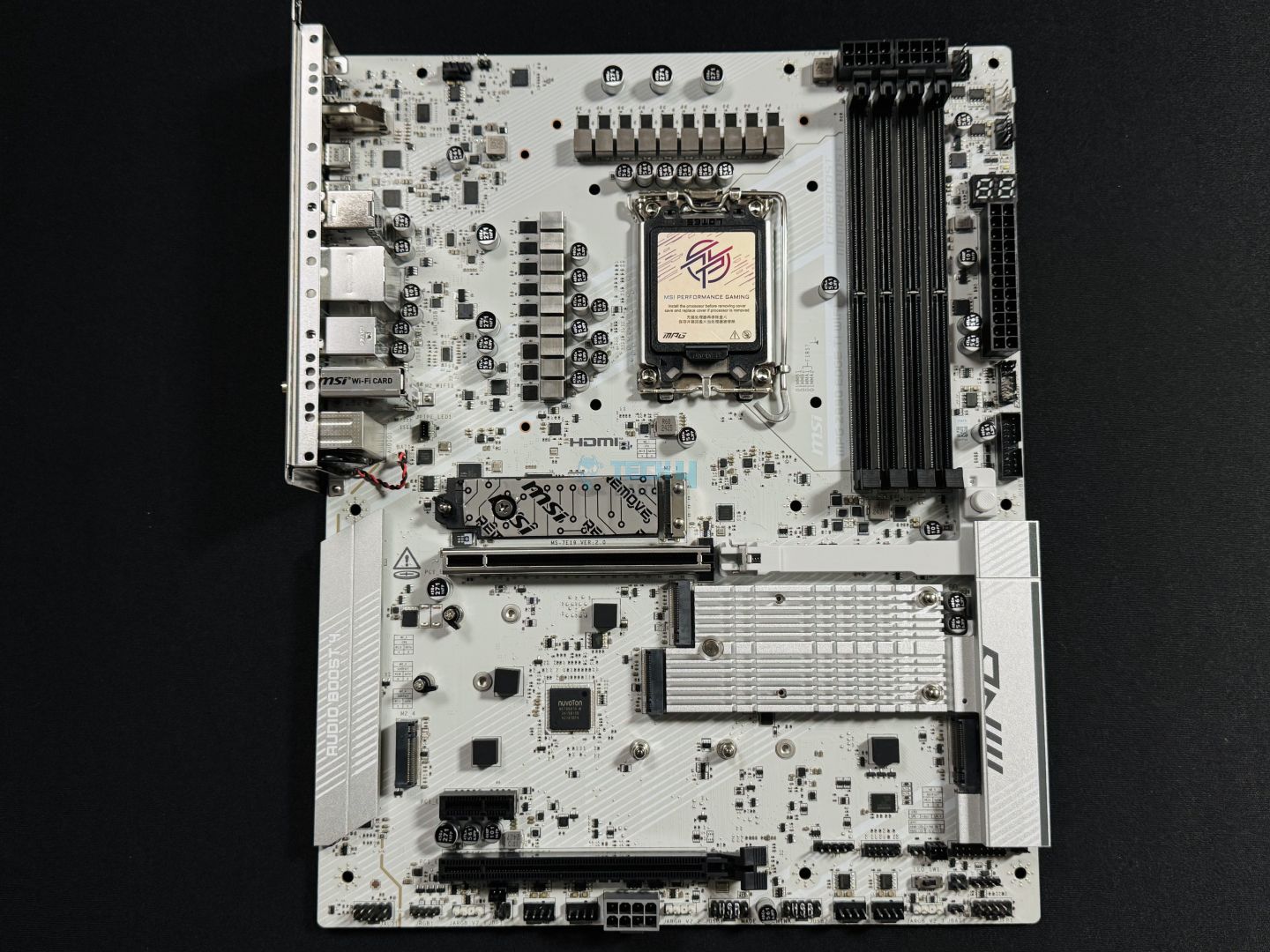
We’ve removed all the heatsinks except the aluminum PCH heatsink.
Test Setup
Here’s a look at our test setup:
- CPU: Intel Core Ultra 9 285K
- Cooling: DeepCool Mystique 360
- Memory: Corsair Dominator Titanium 2x16GB 32GB DDR5-7200 CL34
- Graphics Card: GeForce RTX 4090 Gaming OC
- Power Supply: Corsair HX1200i Platinum
- Storage: Sabrent Rocket 4 Plus G 2TB
- OS: Windows 11 Pro 23H2 64-bit
- BIOS Version: 7E19v2A2
Let’s get into the benchmarks.
Synthetic Benchmarks
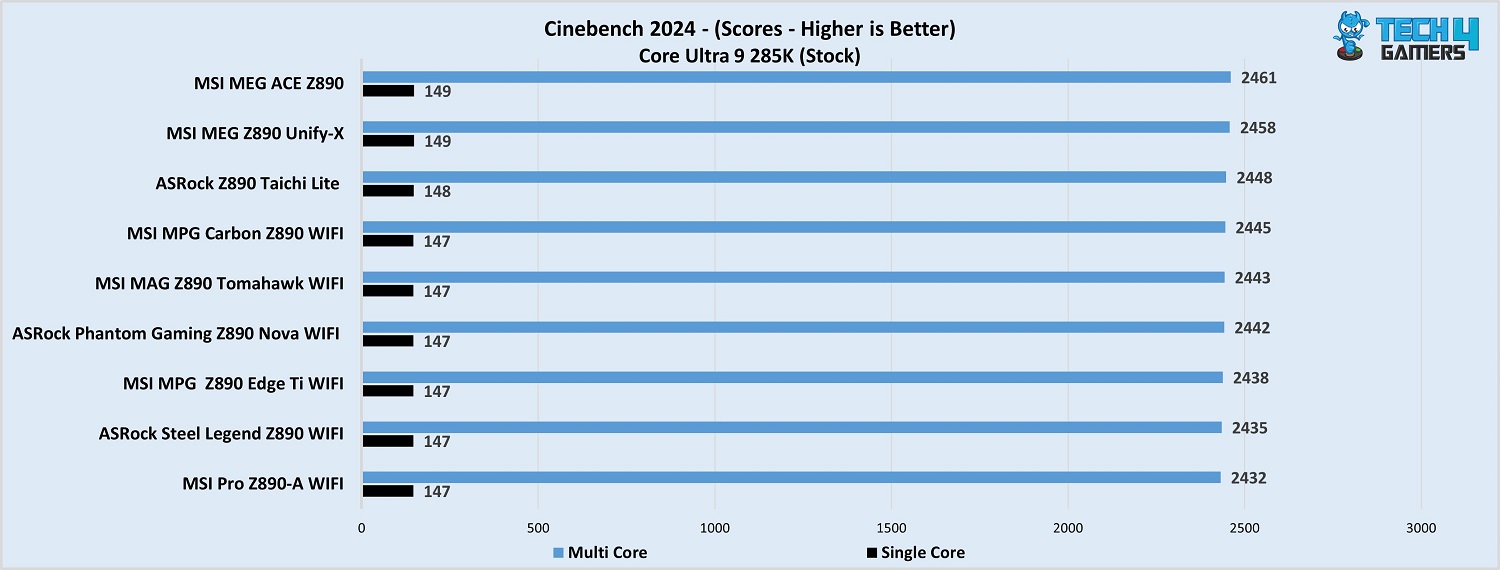
The motherboard posted 2438 and 147 in Cinbench 2024 MT and ST tests, respectively.
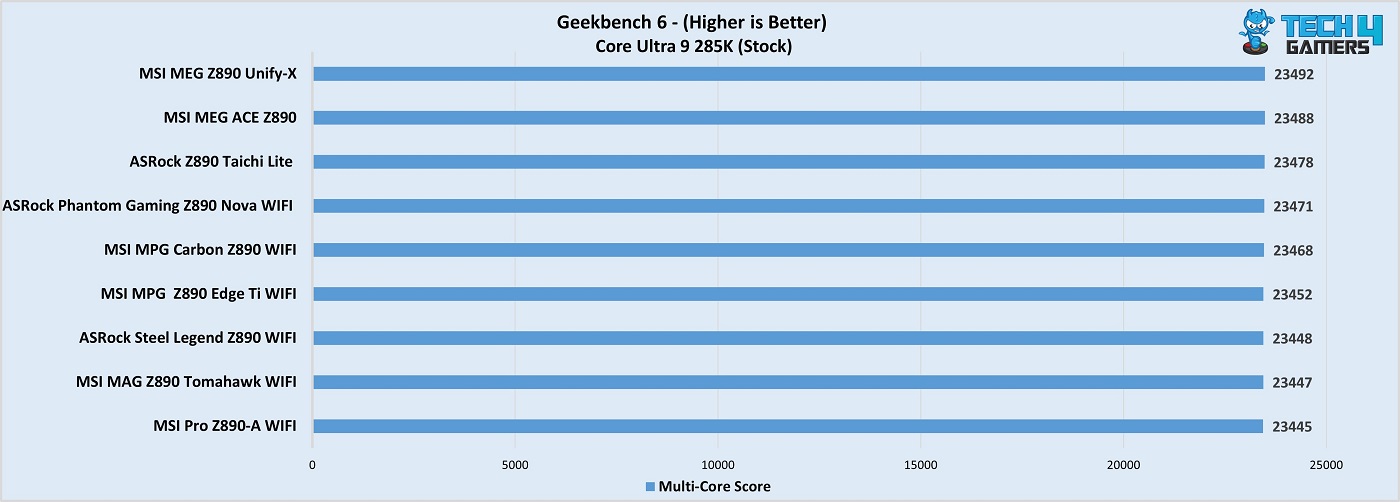
The MPG Z890 Edge Ti WiFi managed 23452 points in this test.
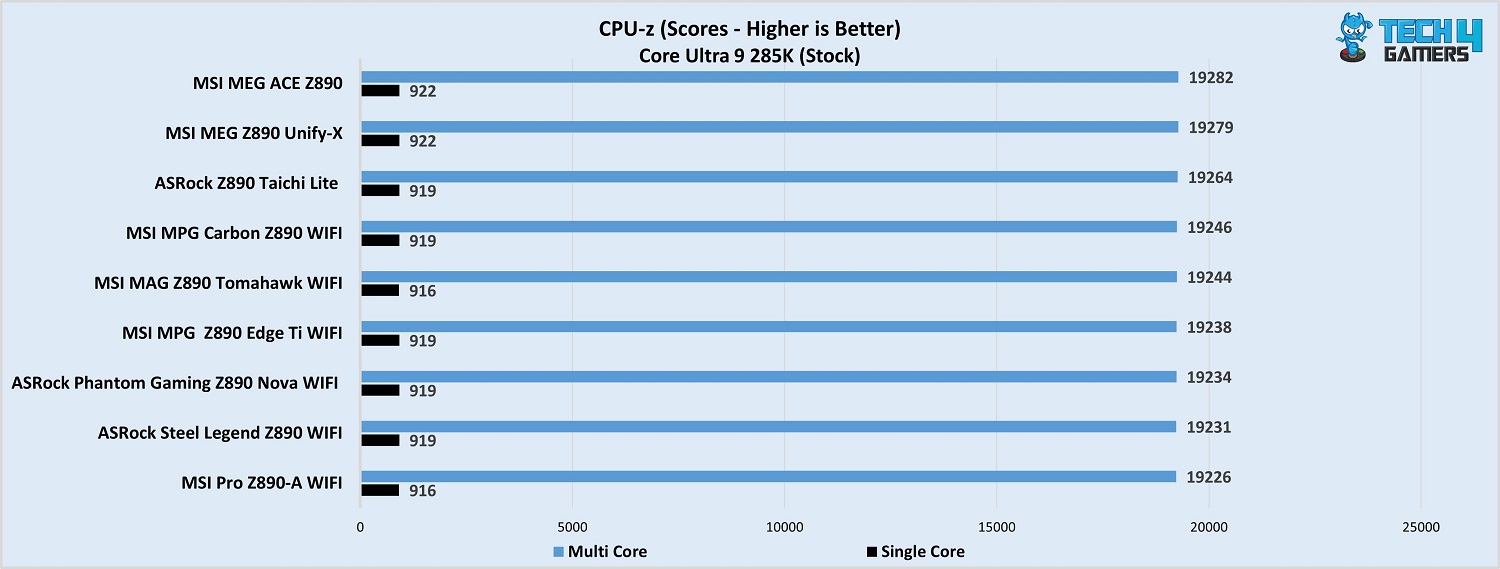
The board stood 6th in this list, but all the boards are within inches of each other.
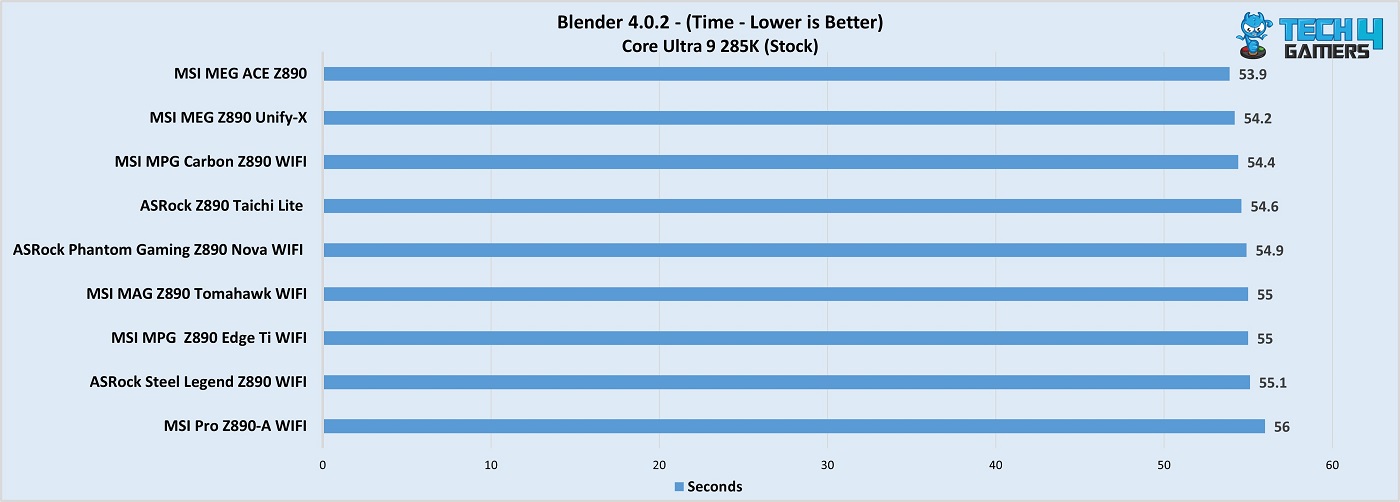
The MPG Z890 Edge Ti WiFi completed the Blender render in exactly 55 seconds, matching the Tomahawk WiFi.
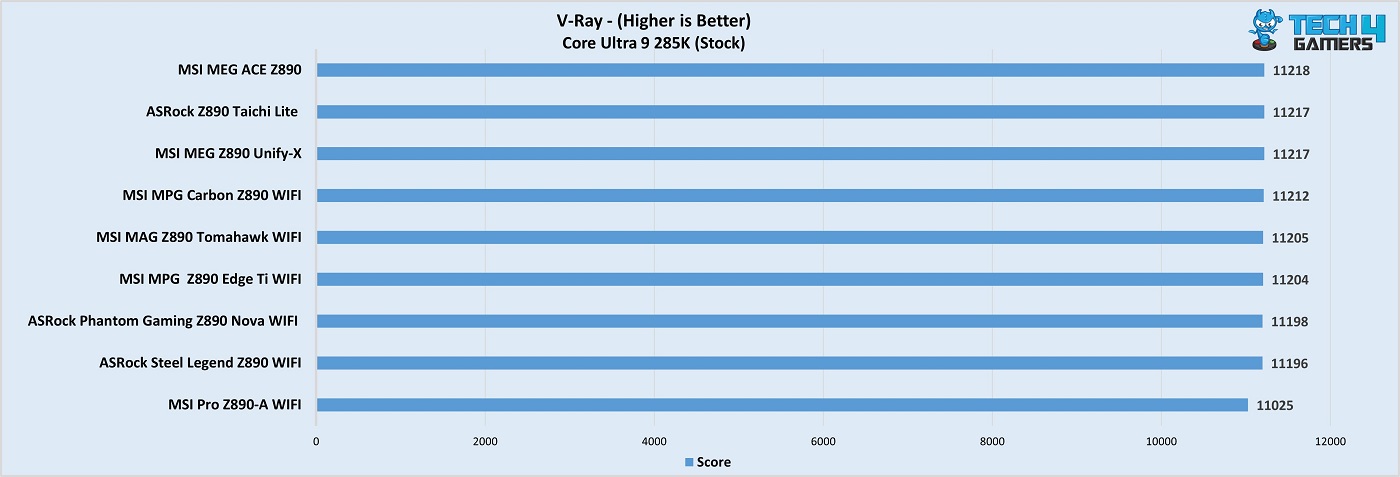
With this board, the system managed 11204 points in the V-Ray benchmark.
The performance of the board in synthetic benchmarks is just as expected.
Gaming Benchmarks
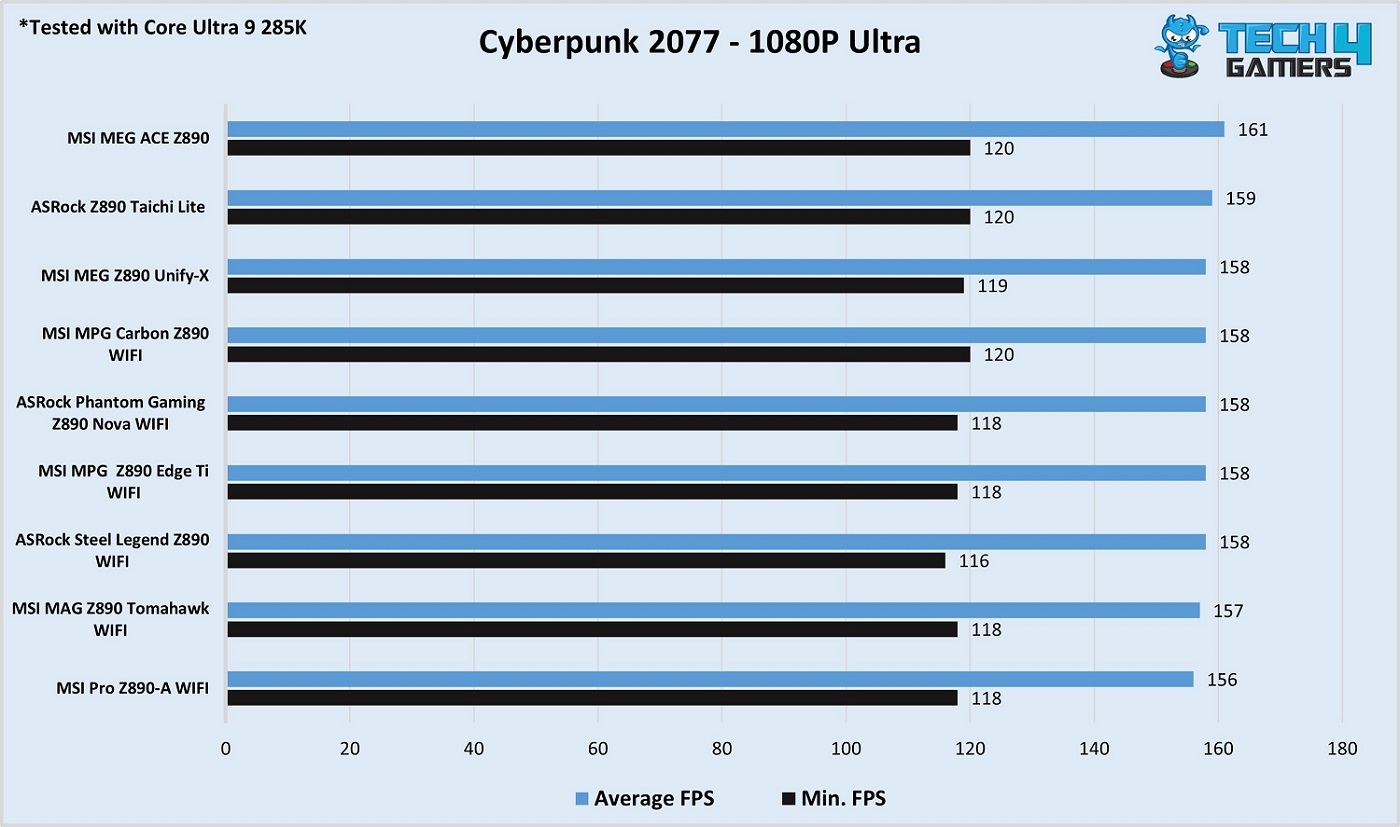
The board managed an average of 158 FPS and dropped to 118 the lowest in Cyberpunk 2077.
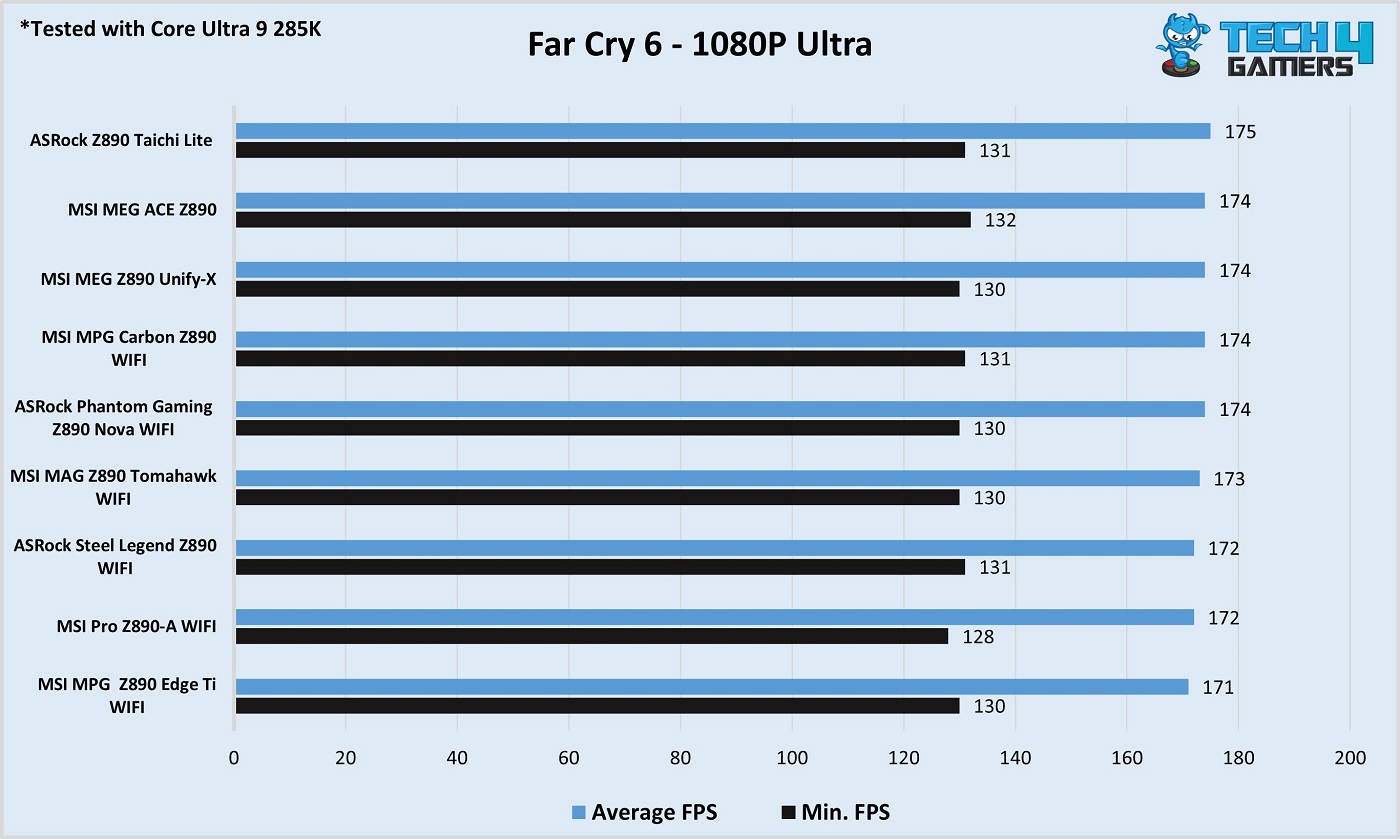
In Far Cry 6, the MPG Z890 Edge Ti WiFi’s average FPS output was 171, and a minimum of 130 FPS.
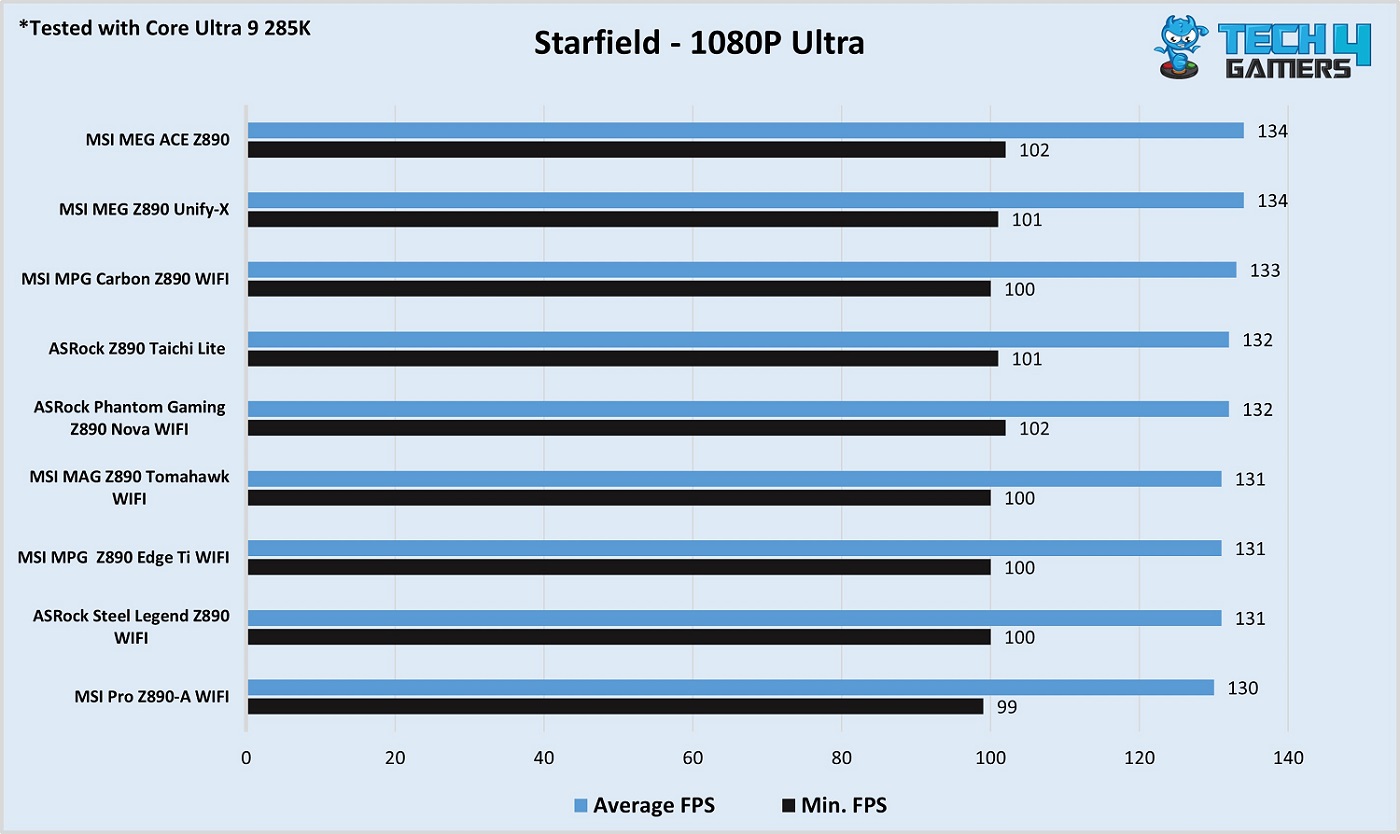
Finally, in Starfield, we saw the board trailing the more premium boards by 3 FPS at worst.
The board’s gaming performance is also quite satisfactory. At most, there’s a 2-3% difference between this board and the more high-performance, costly boards in our list.
Power Consumption and VRM Temperatures
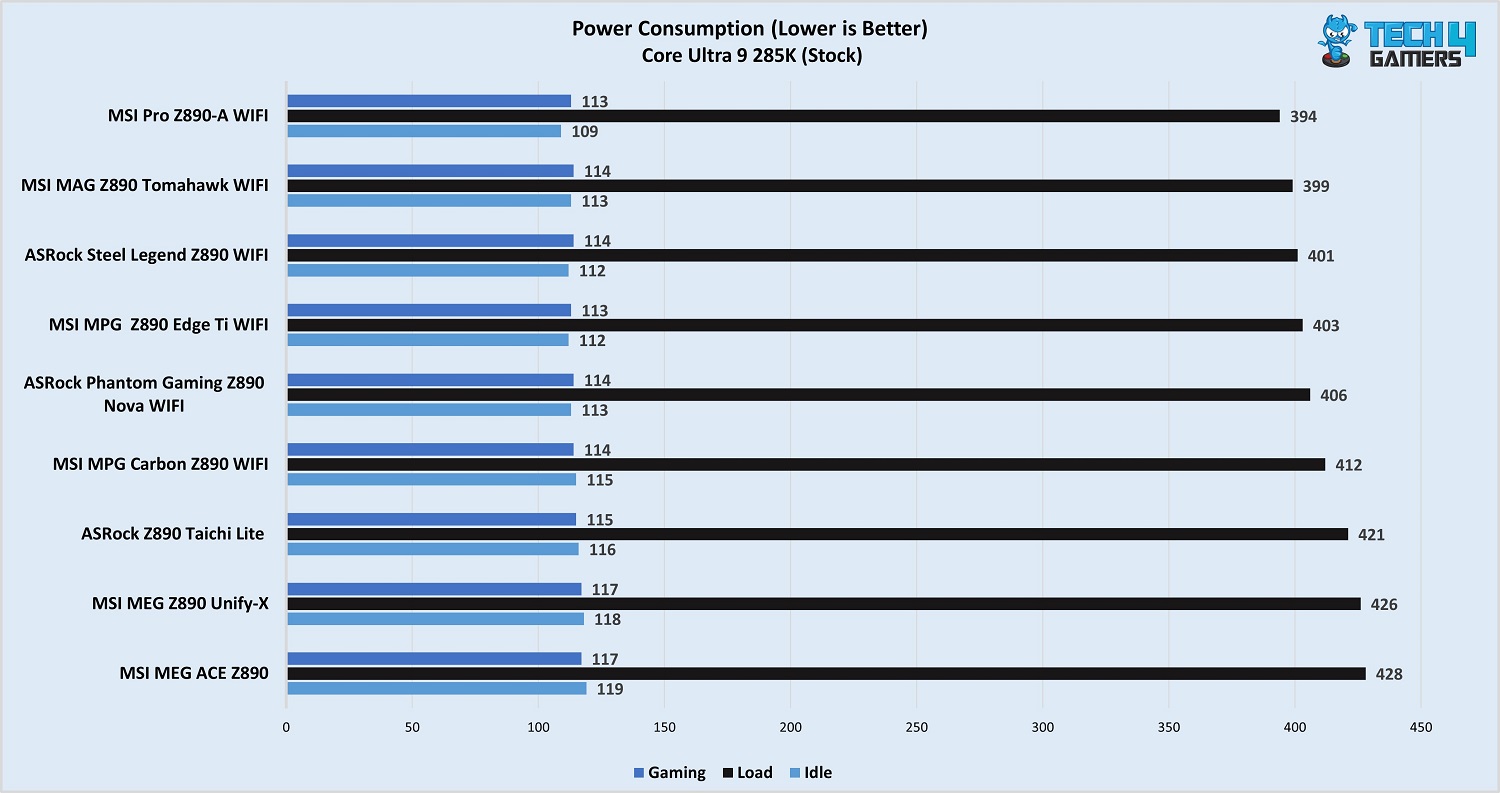
The board’s power consumption numbers turned out fairly low, with 403W under 100% load, 113W while gaming, and 112W at idle.
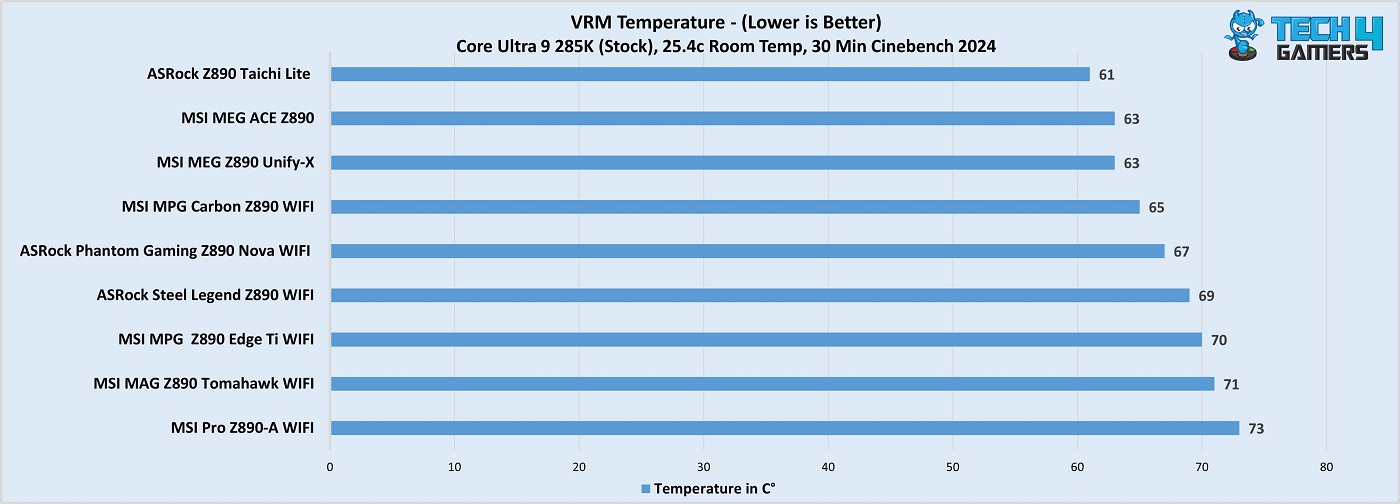
VRM temperatures on the board topped at 70°C during the 30-minute Cinebench 2024 multi-threaded run.
Should You Buy It?
Let’s make a decision.
Buy It If:
✅You’re building a white-themed build: For white-theme enthusiasts, this board offers a fantastic all-white design and includes RGB, too.
✅You want to maximize convenience: The board offers plenty of EZ-DIY features, including EZ PCIe release and the EZ M.2 clips for SSD installation/removal. On the software side, you get EZ overclocking and MSI Center’s EZ optimization.
✅You want the latest I/O: PCIe Gen 5 for GPU and NVMe SSD, Thunderbolt 4, WiFi 7, and Bluetooth 5.4; this board has it all!
✅You need ample storage space: With room for up to 5x NVMe drives and 4x SATA devices, you’ll probably never run out of storage space.
Don’t Buy It If:
❌You’re an enthusiast overclocker: If you need a motherboard with reliable high-end overclocking capabilities, the board’s VRMs may not serve the purpose (though mild overclocking is okay!).
My Thoughts
The MSI MPG Z890 Edge Ti WiFi puts up an interesting proposition with its $369 price tag. For that price tag, you get a stunning all-white design, a ton of incredible features, decent performance, and all the latest I/O you could ask for. While it reuses its design from an earlier X870 motherboard, the white theme and the glossy silver accents add a touch of freshness that we can’t deny!
For VRMs, the board has a 16+1+1+1 setup with 16x 90A SPS for VCore. The setup is more than enough for the comfortable operation of any Arrow Lake CPUs, but heavy overclocking isn’t a fair expectation. For $369, I feel like MSI could have offered a bit more in this department, which is why I called this an interesting proposition. Everything else is solid.
Moving on to memory, the board supports up to 256 GB of memory. The maximum supported speed is 9200 MT/s with single-rank RAM at 1 DIMM per channel. CUDIMMs are supported. Storage space on the board is more than plenty, with 5x M.2 slots (including a Gen 5) and 4x SATA 6G ports. EZ Toolless M.2 heatsink removal and EZ M.2 Clips II make SSD installation an absolute breeze.
For your GPU, the board has a Gen 5 x16, surface-mounted, and steel-reinforced slot. Additionally, there are two Gen 4 slots at x4 and x1 configurations. The Gen 5 slot has an EZ PCIe release mechanism, which we love to use every time we look at an MSI board. There are 19 USB ports on offer for USB connectivity, including 2x Thunderbolt 4.
The board has WiFi 7 and Bluetooth 5.4 for wireless connectivity. There’s a 5G LAN port if you prefer a wired connection. The dedicated Intel Killer utility for WiFi/LAN offers some handy features, including auto application prioritization and smart access point selection.
The board uses Realtek’s ALC1220 solution and the ESS 9118 DAC for audio. MSI’s Audio Boost 4 adds features, including high-quality capacitors and a dedicated headphones amplifier, to improve the audio quality.
As with all other MSI motherboards we’ve reviewed recently, the main highlight remains the EZ-DIY features offered. In addition to those features we just mentioned, the EZ Digi-debug LED, EZ-Conn Cable, and pre-installed I/O shields add further convenience.
The board has a Thunderbolt 5 connector. An extra PCIe connector on the board can provide up to 252W to alleviate the load on the 24-pin ATX connector and supports 2.5x power excursion for the GPU.
MSI is offering a 3-year warranty for the board. We thank them for sending it to us for review.
Thank you! Please share your positive feedback. 🔋
How could we improve this post? Please Help us. 😔
[Reviews Specialist]
Usman Saleem brings 8+ years of comprehensive PC hardware expertise to the table. His journey in the tech world has involved in-depth tech analysis and insightful PC hardware reviews, perfecting over 6+ years of dedicated work. Usman’s commitment to staying authentic and relevant in the field is underscored by many professional certifications, including a recent one in Google IT Support Specialization.
8+ years of specialized PC hardware coverage
6+ years of in-depth PC hardware analysis and reviews
Lead PC hardware expert across multiple tech journalism platforms
Certified in Google IT Support Specialization
Get In Touch: usman@tech4gamers.com


 Threads
Threads